Zurich – Walking the Old City
This is my sixth post from a recent visit to Switzerland and the first in which we meet up with our fellow Adventures Abroad travellers to start the tour of this wonderful country. We will also meet our guide and friend Victor Romagnoli with whom we have travelled many times. This post will feature a walking tour of old Zurich which I assure the reader will be most interesting, so please come along for the walk.
But first a word or two about the great little hotel that Adventures Abroad has chosen as our Zurich headquarters.
Hotel Adler
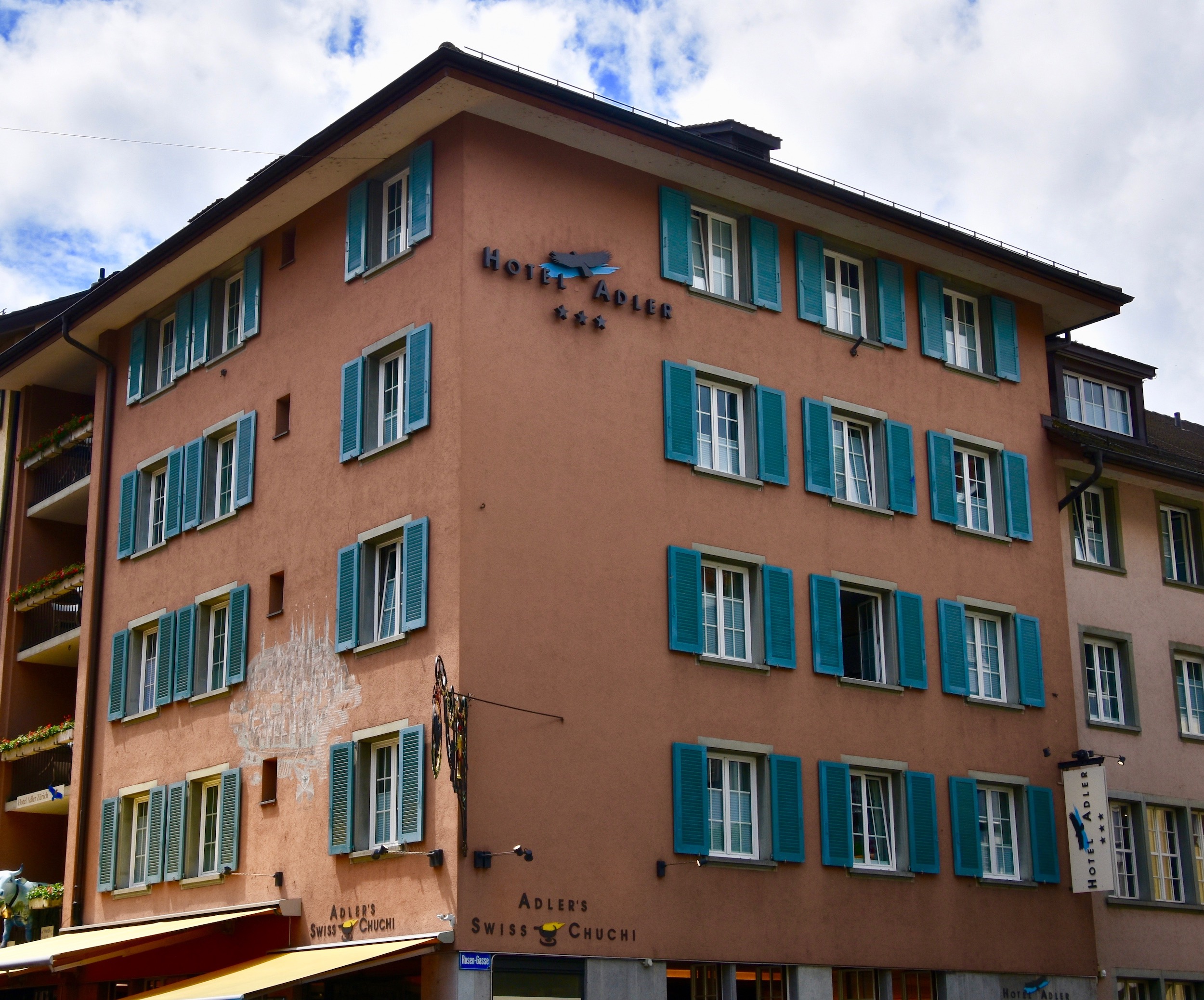
I have frequently commented upon not only the high standards, but the unique qualities of many of the accommodations that Adventures Abroad chooses for their guests. The Hotel Adler in the old part of Zurich fits this description perfectly. It has an ideal location in the middle of the old city just a half block away from the Limmat River that bisects Zurich.
When we checked in they were aware that it was Alisons birthday and had some nice gifts awaiting her.
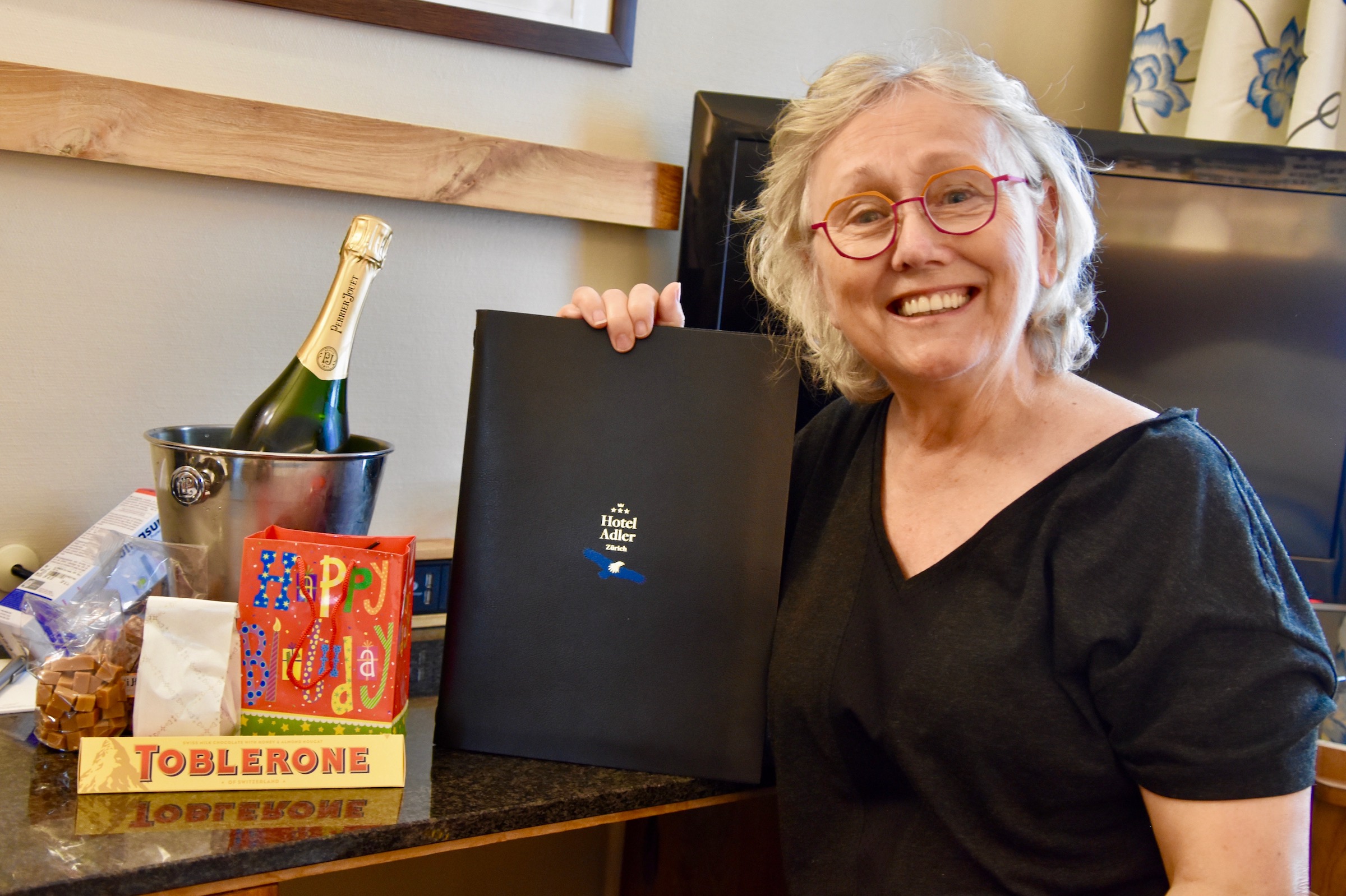
The common areas had some nice touches like this painted atrium.
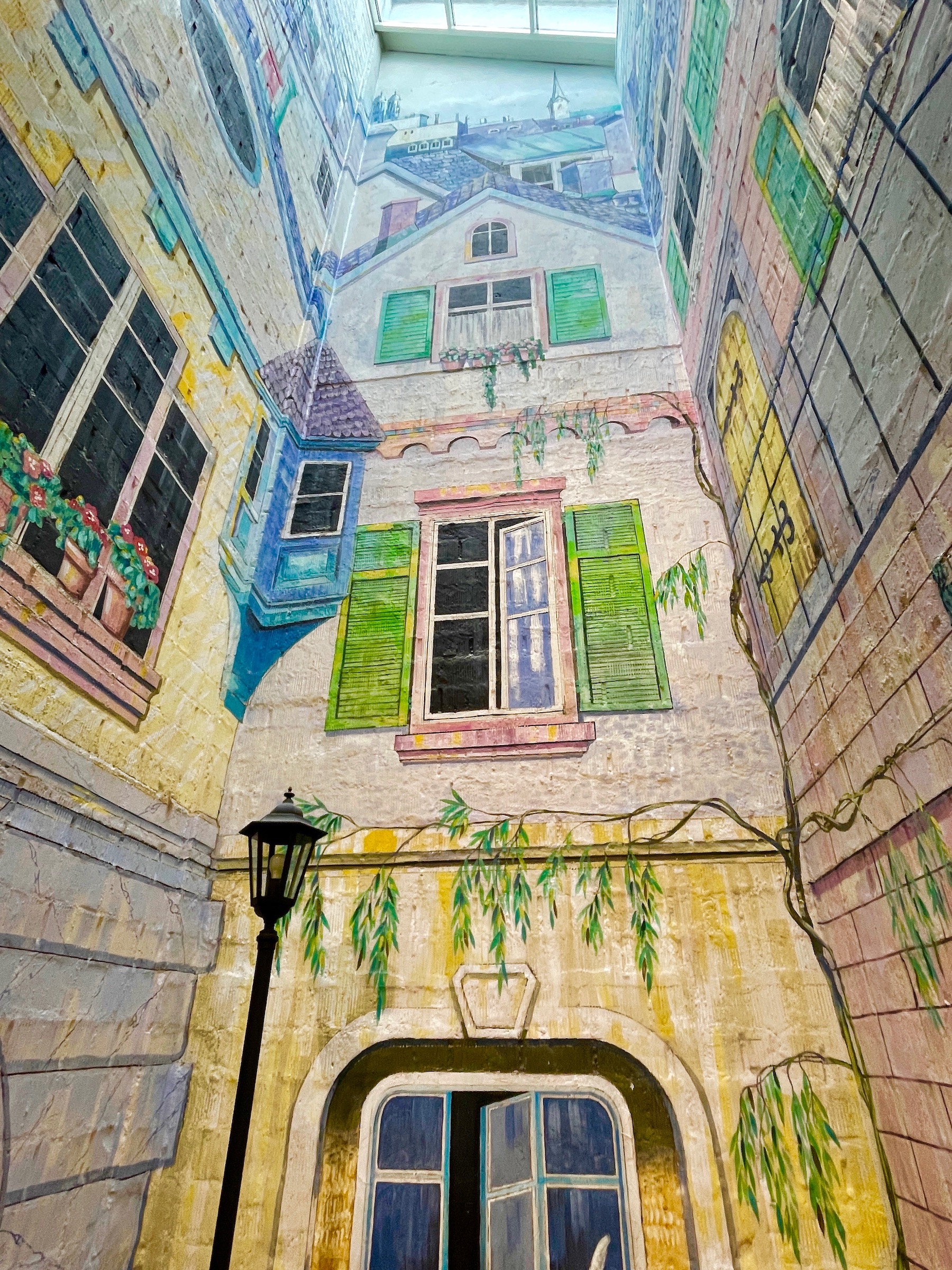
There are also Swiss themed original paintings throughout the hotel by the artist Rudolf Koller whose family once owned the Adler. He is considered to be one of the finest of the 19th century Swiss painters along with Frank Bucher whose works we saw at the Kunstmuseum Basel. So if you do stay here on a future AA trip make sure to take the time to view these excellent works.
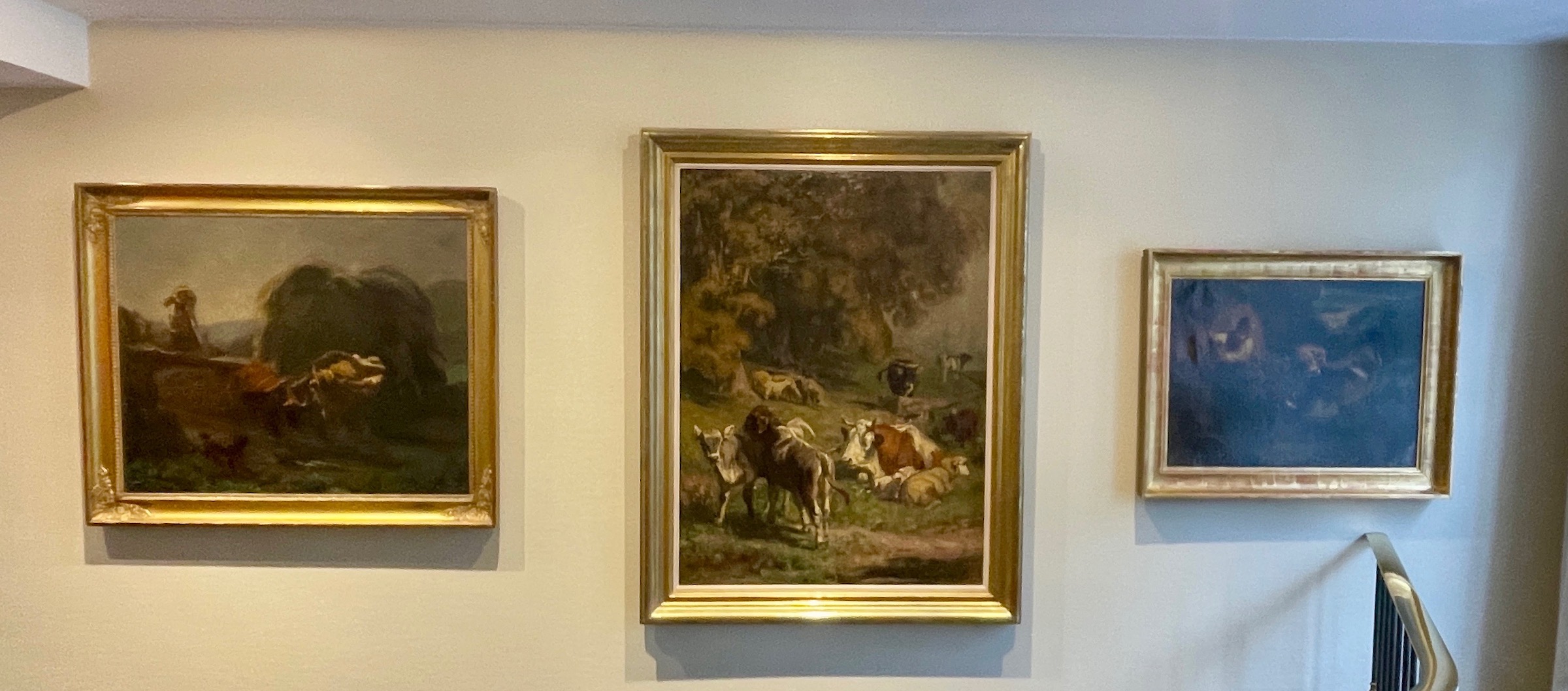
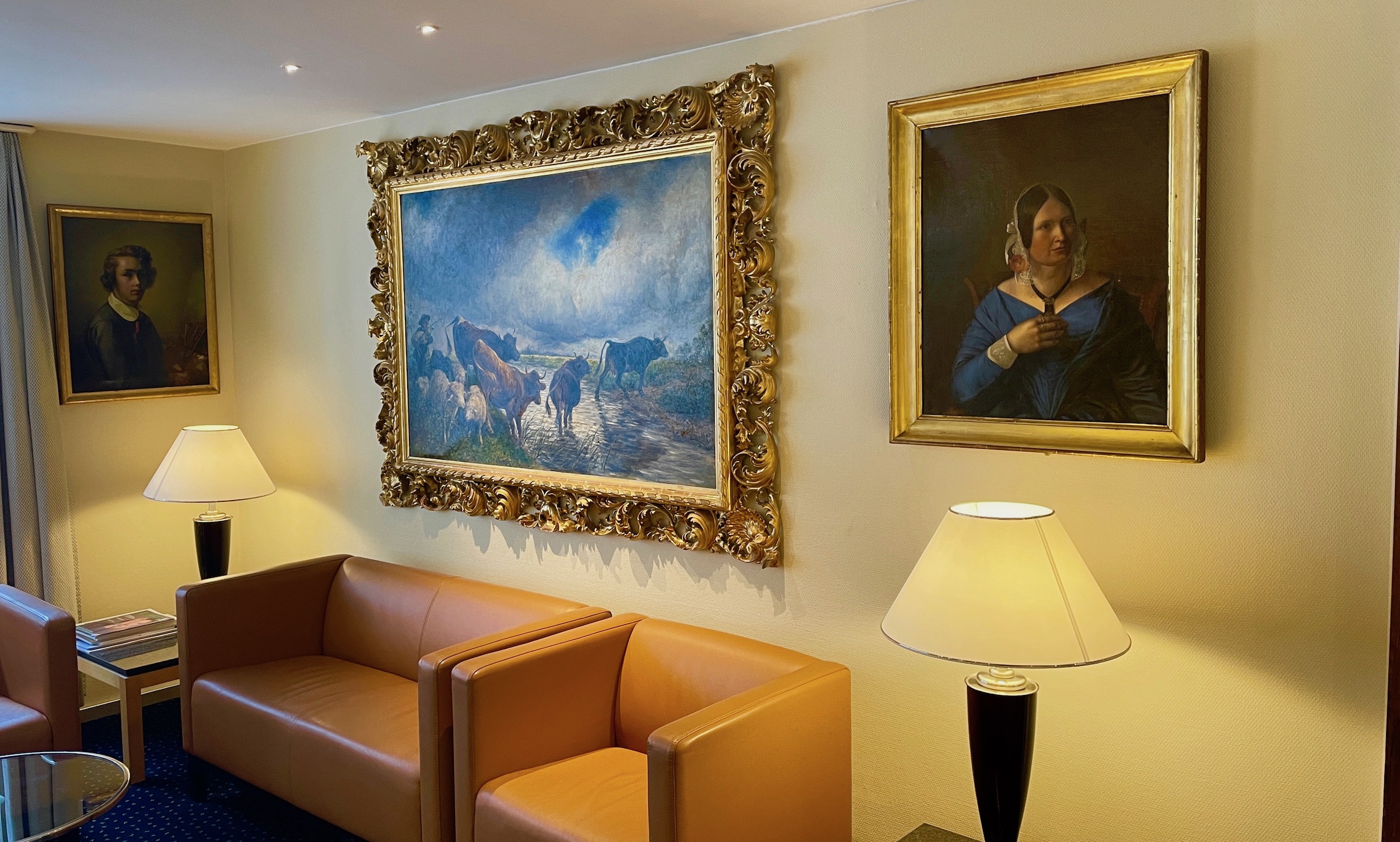
However what makes the rooms at the Hotel Adler truly unique are the paintings on the wall of each room by Basel artist Heinz Blum.. Every one is of a different scene in Zurich and there was a book identifying the places depicted on the walls of each. Ours was of the Schipfe area of Zurich which is one of the oldest in the city and the place where ships have unloaded their cargos since medieval times.
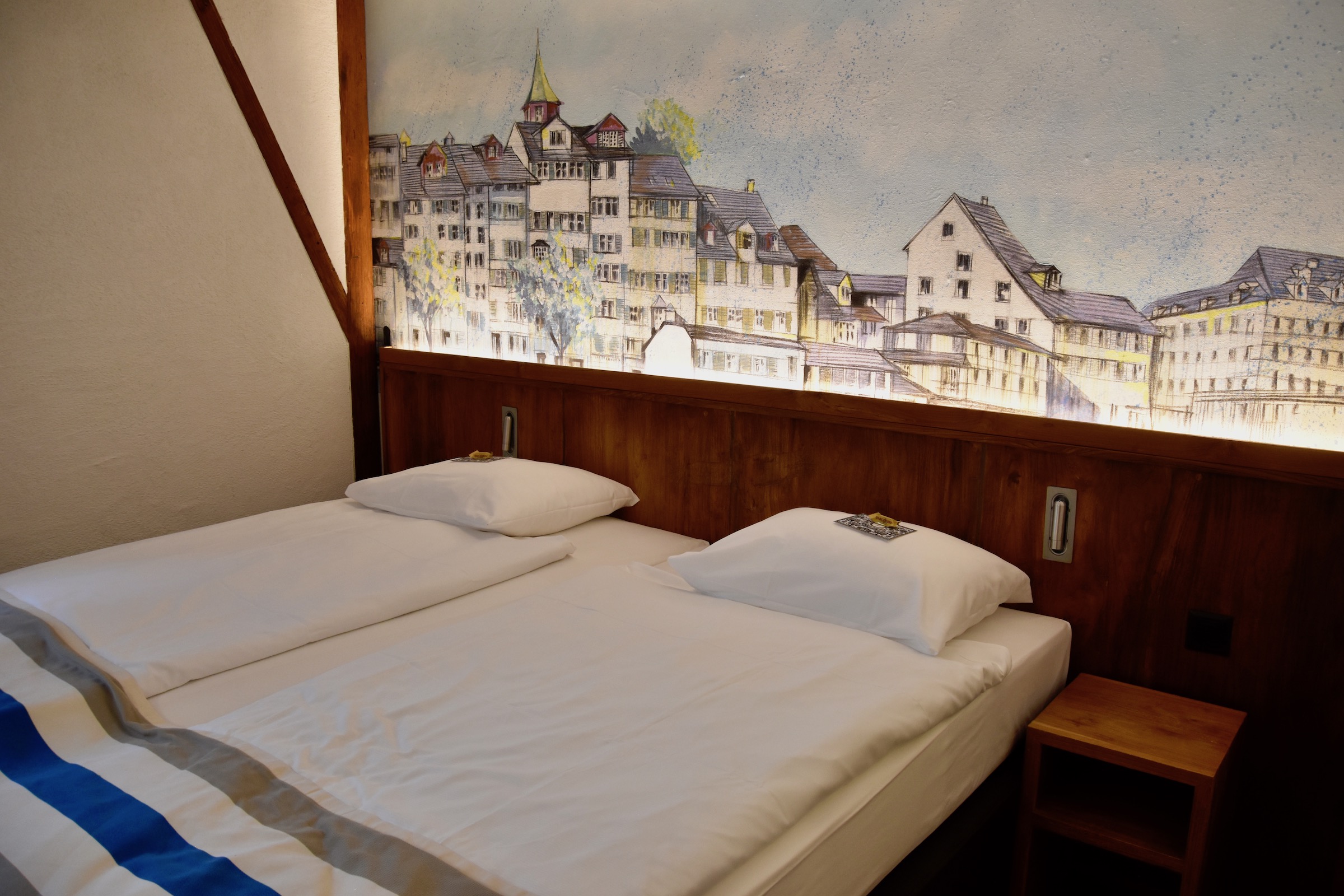
Also in the room was a map with the area which our painting depicts circled in blue.
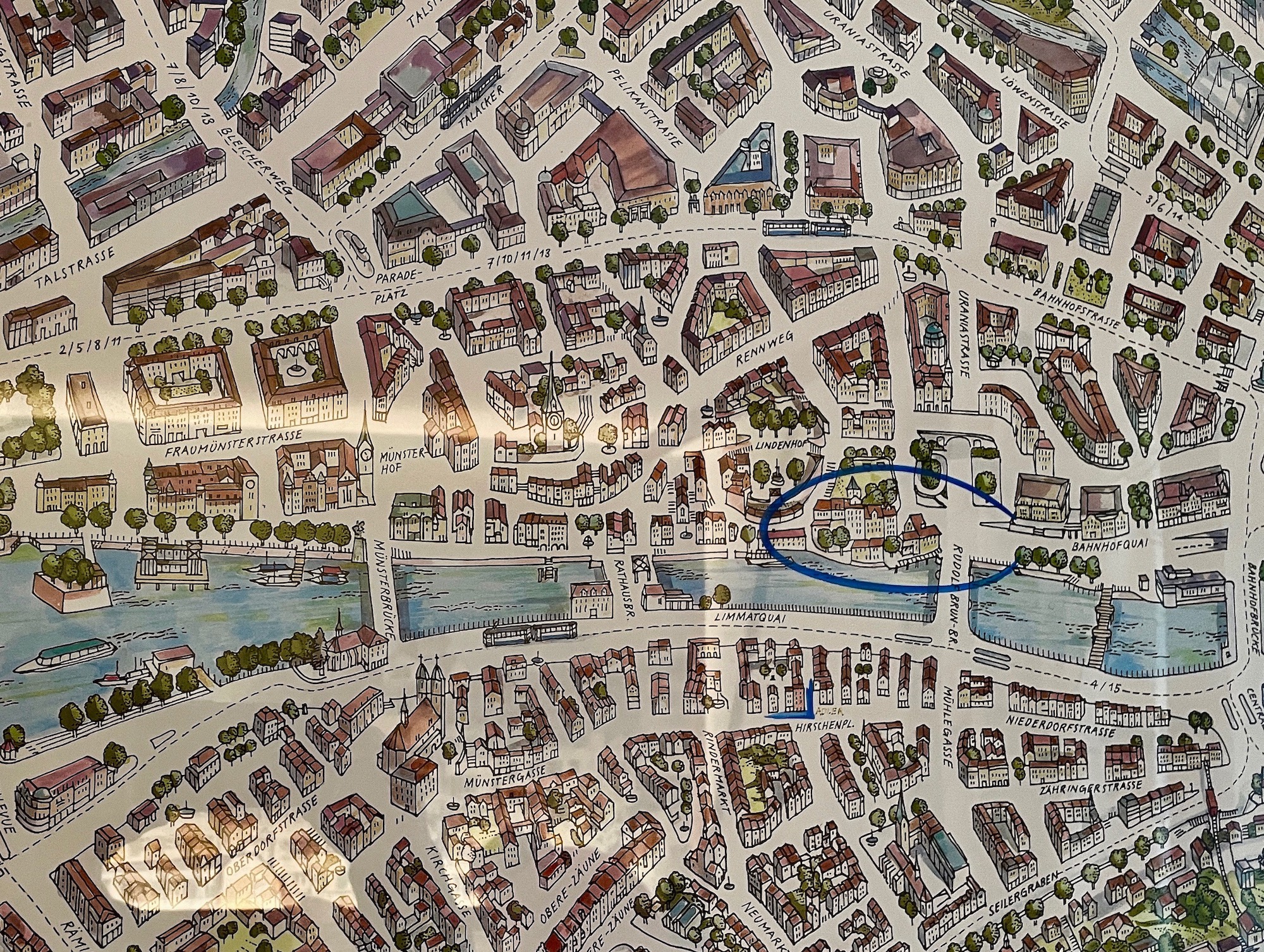
Once I figured this out it only took a few minutes to walk down the Limmatquai to view the Schipfe across the river. I thought this was a pretty neat little thing to do and I encouraged others in the group to seek out their special places.
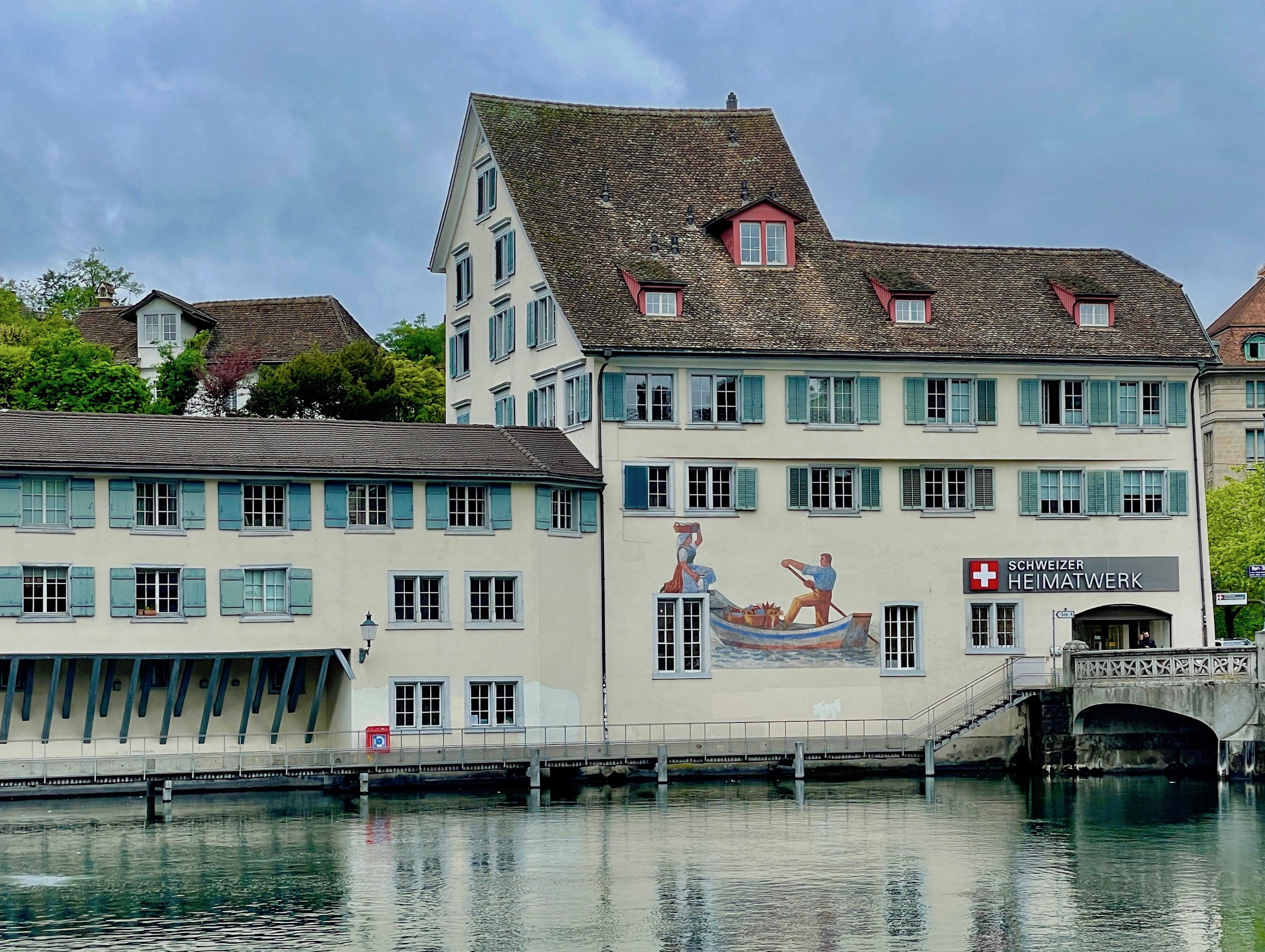
Aside from the rooms the Hotel Adler has a very traditional restaurant, the Swiss Chuchi where we ate on the first night. If you are going to go for a Swiss meal anywhere on this trip this is the place to do it. In Geneva Alison and I had a traditional Swiss cheese fondue and I wasn’t up for repeating it so opted for a meat fondue which is cooked in bubbling oil instead of cheese. Look away if you are a vegan.
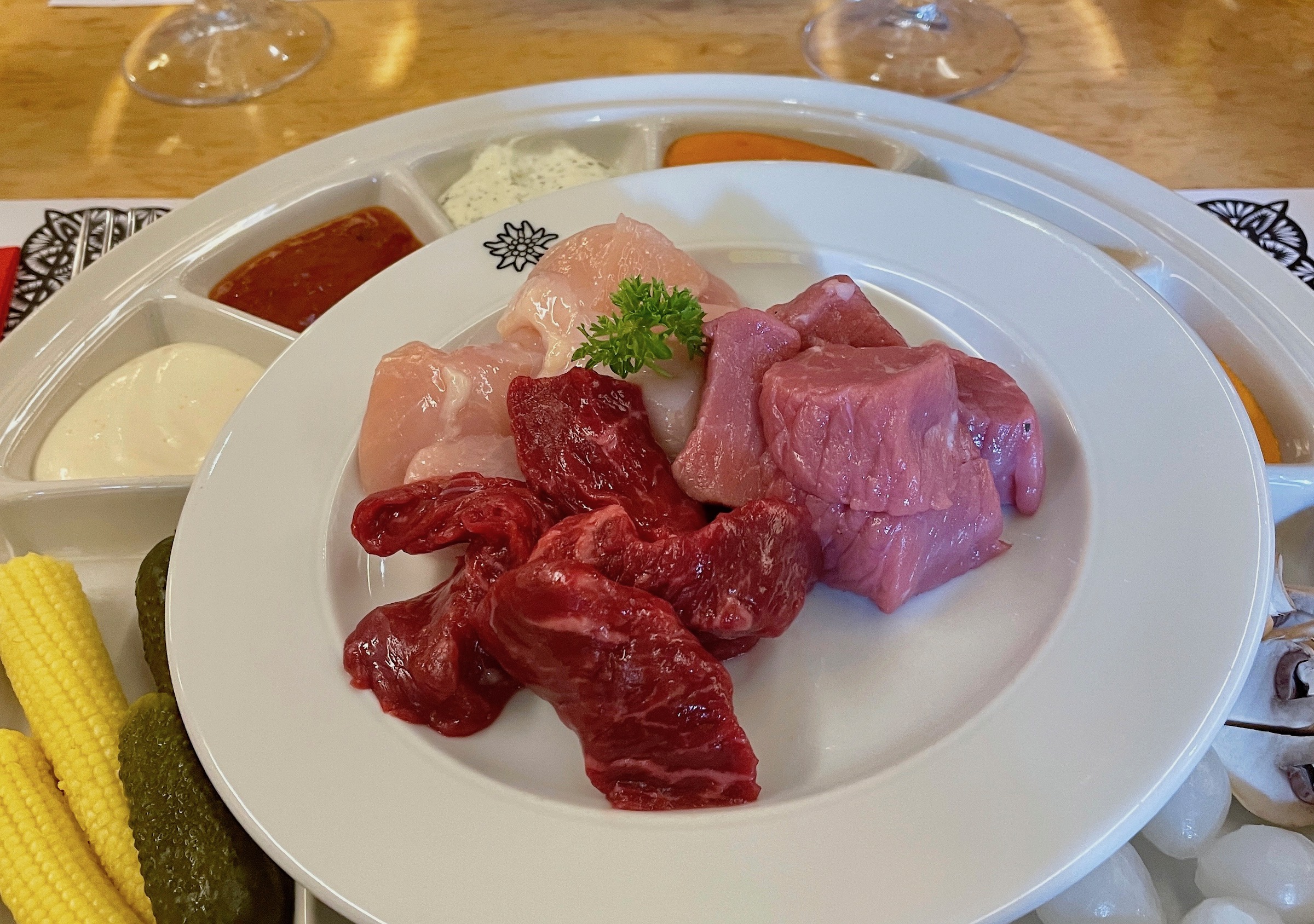
Just before our first dinner we met up with Victor whom we had last travelled with in Malta only a few months earlier. We have travelled with him many times and are now good friends and I always know that with Victor in charge things are under control. We also met our fellow travelling companions who were split evenly between Americans and Canadians. As usual they were all very well travelled and mostly world savvy, knowing that while Canada and the U.S. are great countries, they are by no means the only ones and in many cases not the world’s best by a long shot.
As he does with every trip Victor creates a calendar of events with little drawings for each day’s activities. I find these among the best keepsakes from the trips he leads.
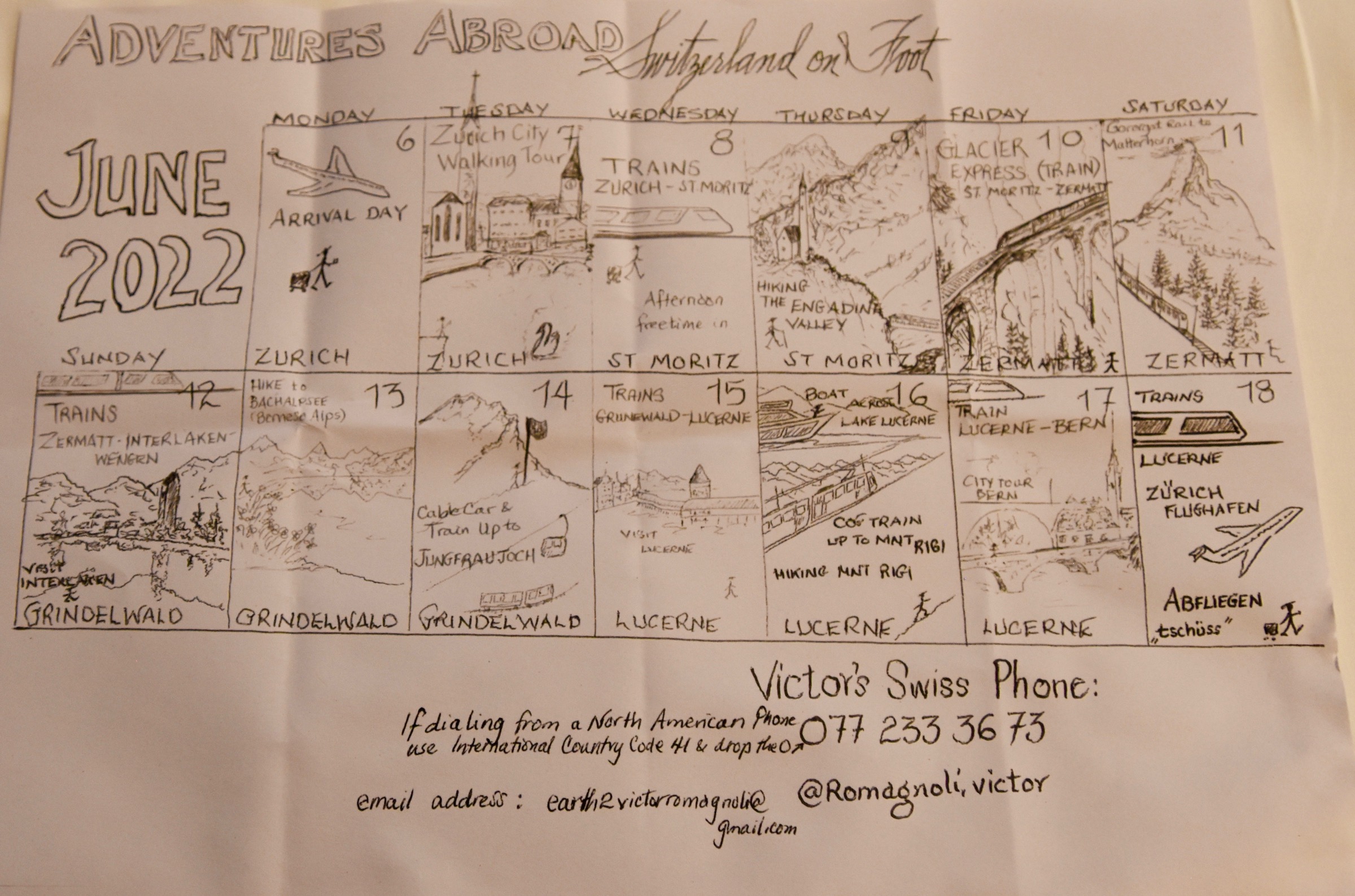
Walking Tour of Old Zurich
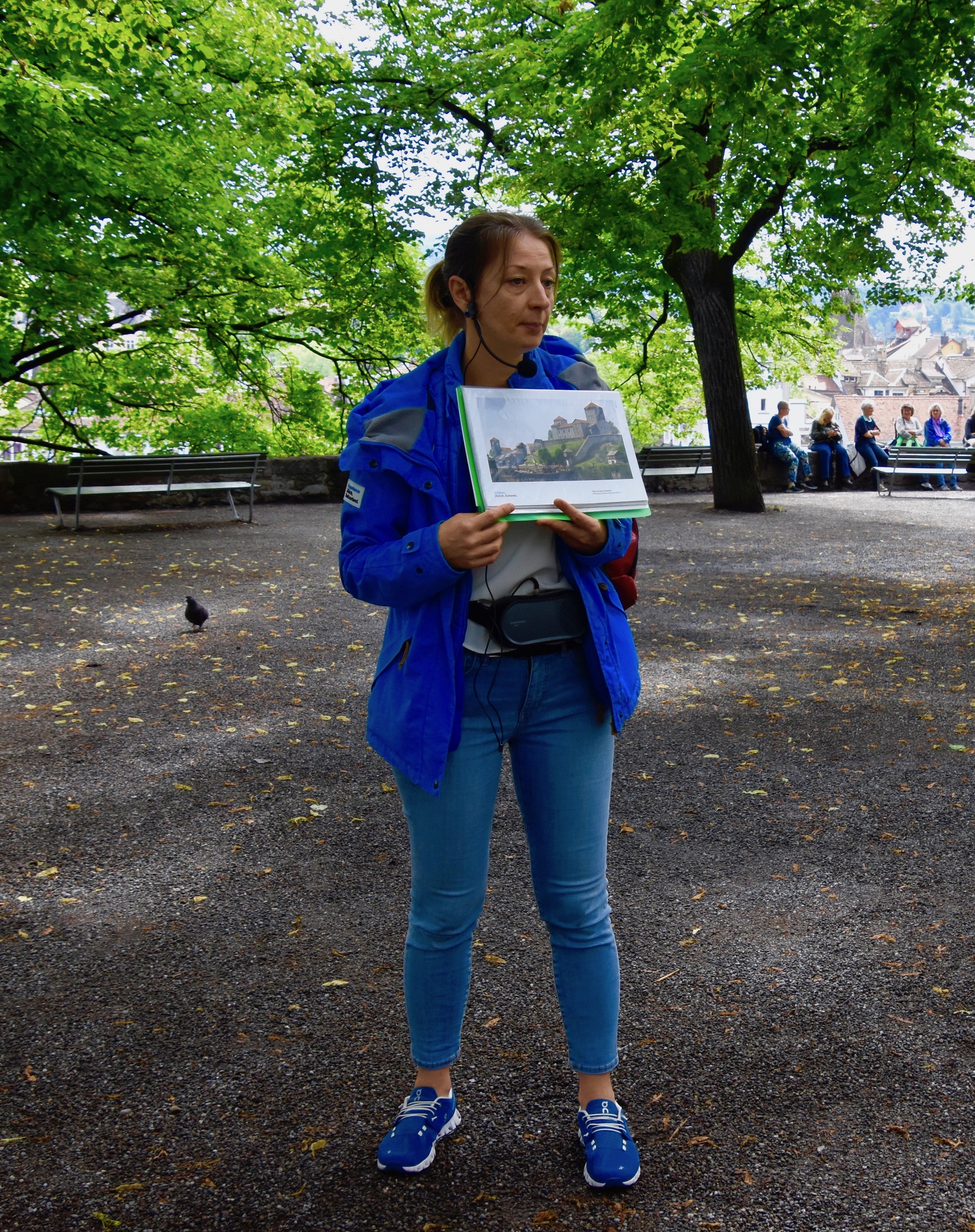
This is local guide Alla Dacher who will start our first full day on the tour off with an extensive walking tour of old Zurich.
First she gives us a quick history of the city and we learn that Zurich was actually founded by the Romans who called the place Turicum. It did not get its present name until much later and there is still a debate as to what it means and where it came from. The highlights of Zurich history include the fact that for hundreds of years in the Middle Ages it was under the de facto control of a woman, the abbess of the Fraumünster which was founded by a grandson of Charlemagne, for his daughter Hildegard. Later the guilds effectively ruled the city and like Basel it never seems to have had to pay homage to any of the greater powers of central Europe. Zurich first joined the Swiss federation in 1351, but got the boot in 1440 for starting a war with other federation members. It lost that war and got readmitted in 1450 and thereafter became one of the most powerful and richest of the Swiss cantons.
While John Calvin got the Reformation under way in Geneva in 1536, he was by no means the first Swiss reformer. That honour goes to Huldrych Zwingli, the people’s priest of the Grossmünster in Zurich, who started his attacks on Catholic orthodoxy as early as 1519. By 1525 Zurich was thoroughly in his grip and thus arguably became the first Protestant city in the world.
Fast forward a few hundred years and Zurich has become the banking hub of continental Europe and depository of much of the ill gotten gains of dictators and kleptocrats from around the world. However, the old city is not where the banks are located so we not get to the financial sector on this walk. With that prologue, let’s head out.
Alla leads us from the Hotel Adler down to the Limmatquai and across the river Limmat to our first stop.
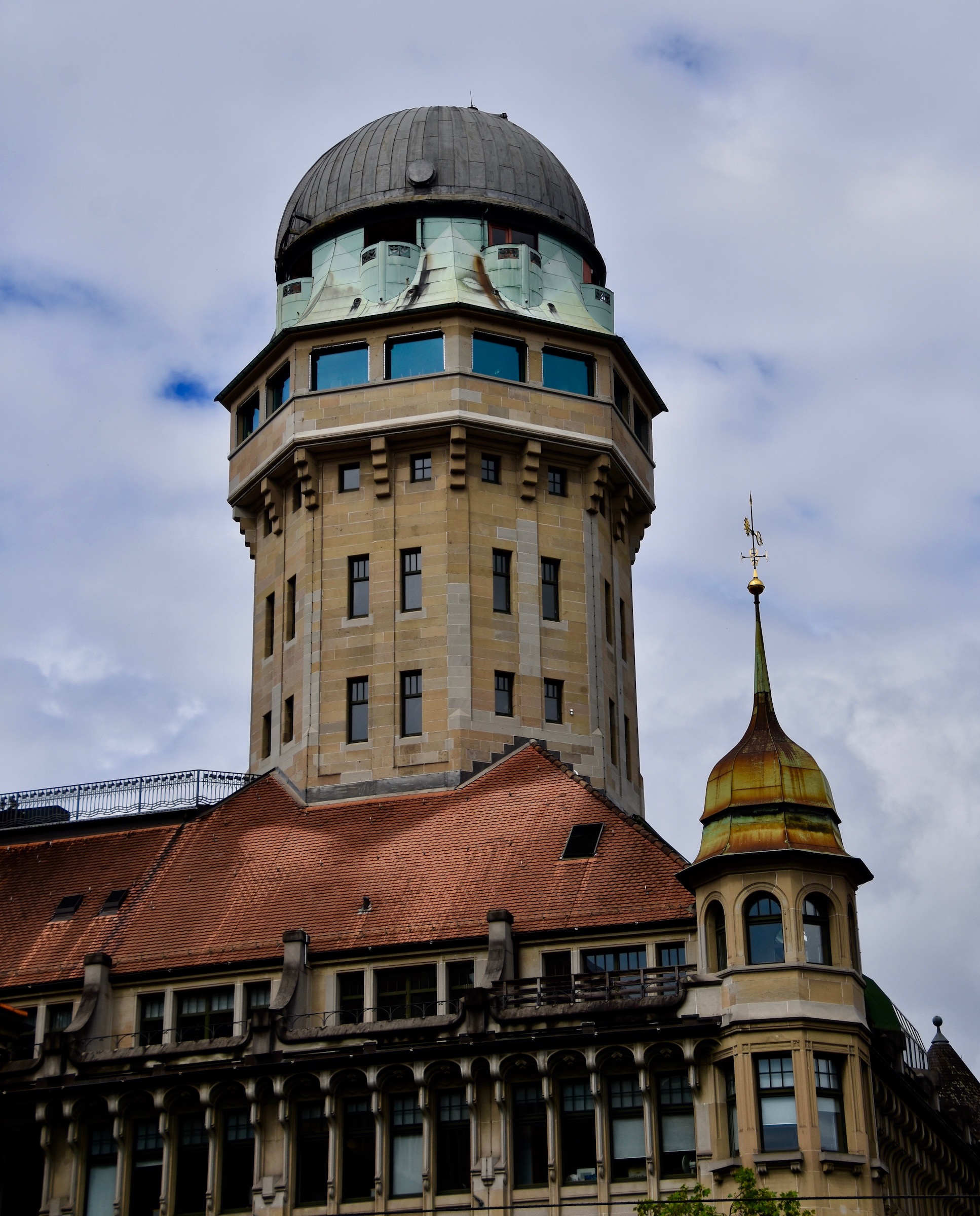
This strange looking tower is the Urania Sternwarte which is actually an astronomical observatory that is over a century old. Although we don’t go inside I can see people up in the cupola area from down below.
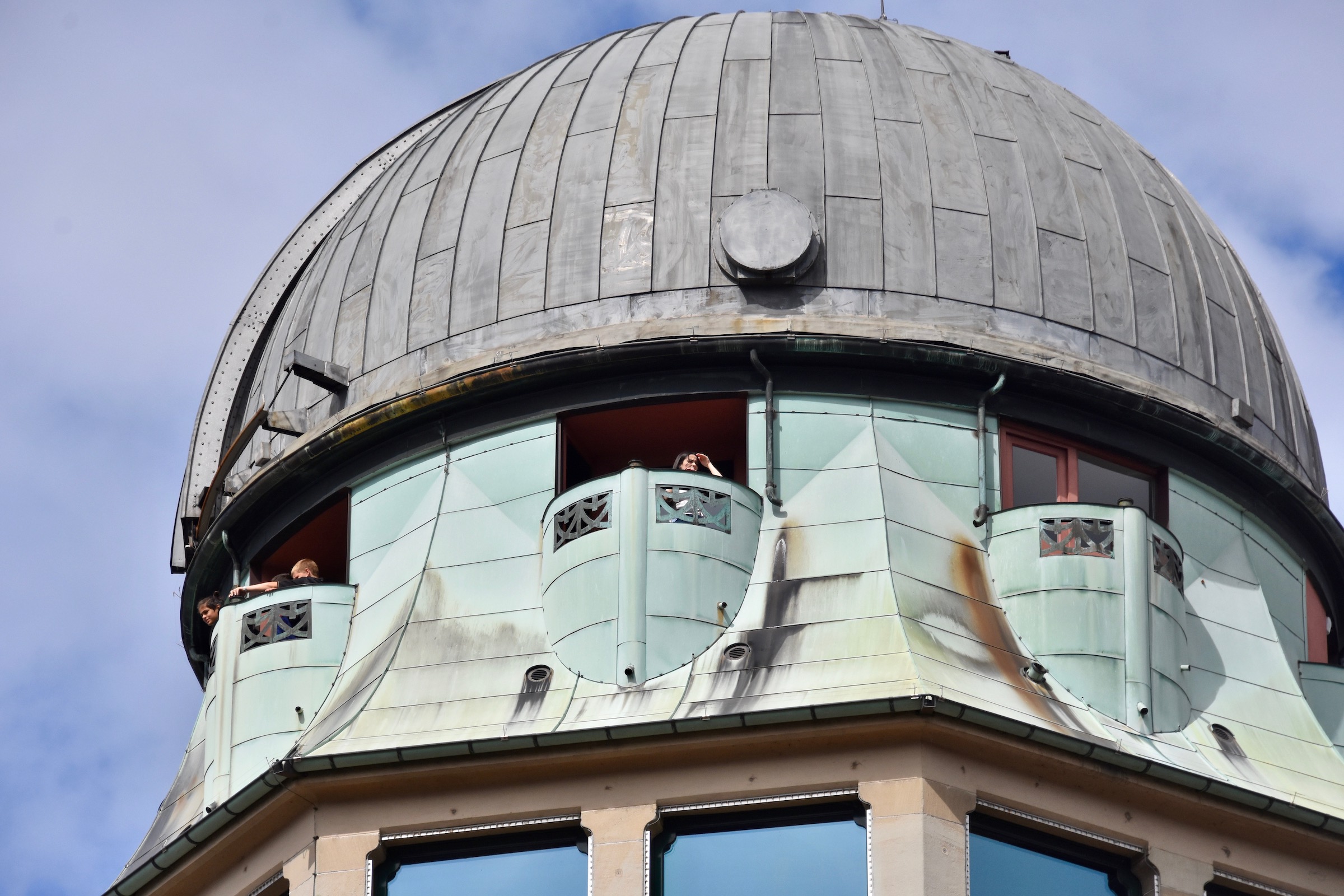
Our next stop is quite unusual, the Zurich police headquarters. Not that anyone in our group needs to be arrested, but rather to see the marvellous interior created by Augusto Giacometti.
This is the former Waisenhaus, an orphanage that is the only building left from the vast Oetenbach nunnery.

In the 1920’s the city decided to establish the police headquarters here and Augusto Giacometti was hired to spruce up the place which he surely did. Alla asks for and receives permission for us to enter and we are all blown away by what we see – a riot of Art Nouveau ceilings.
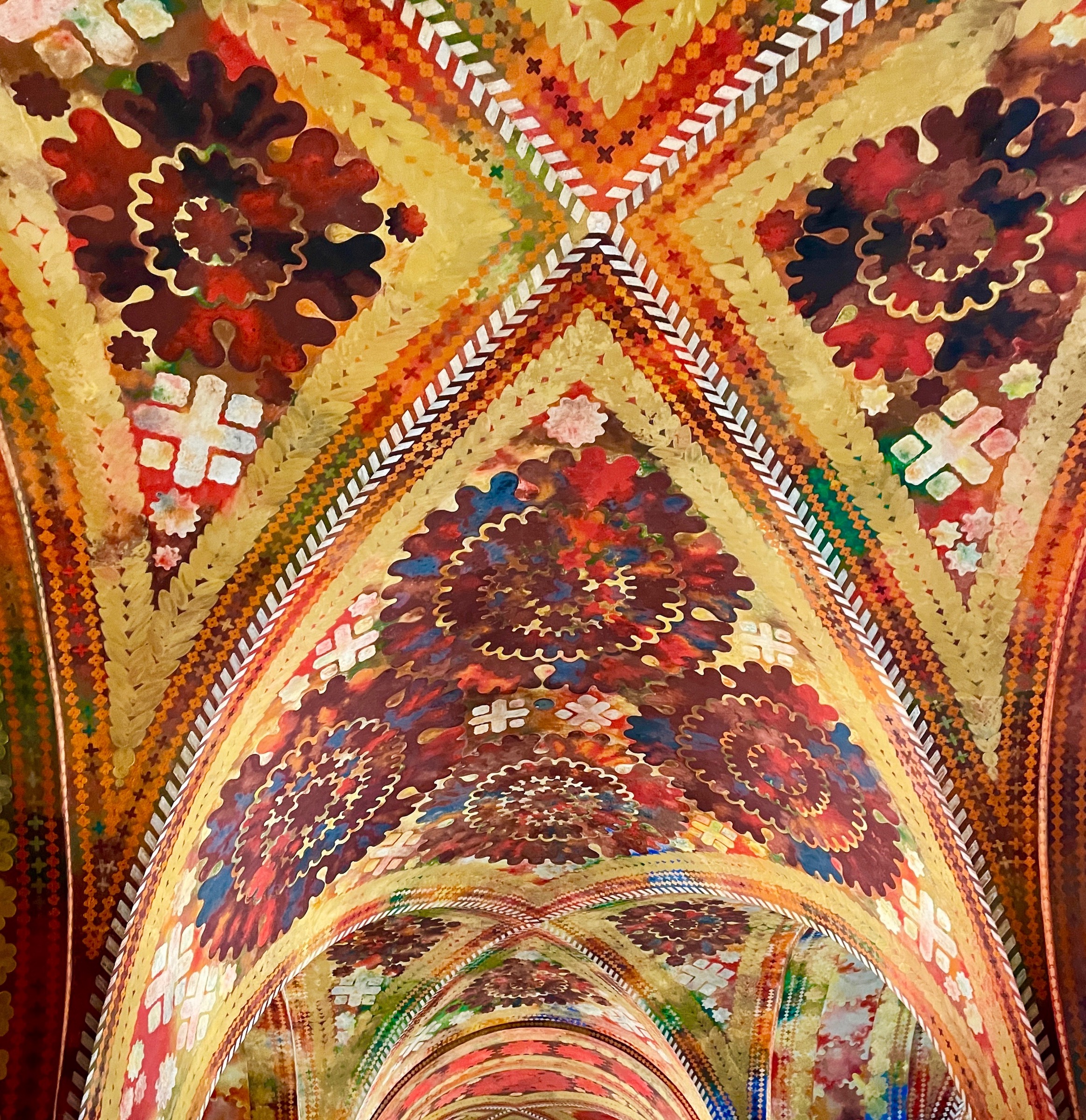
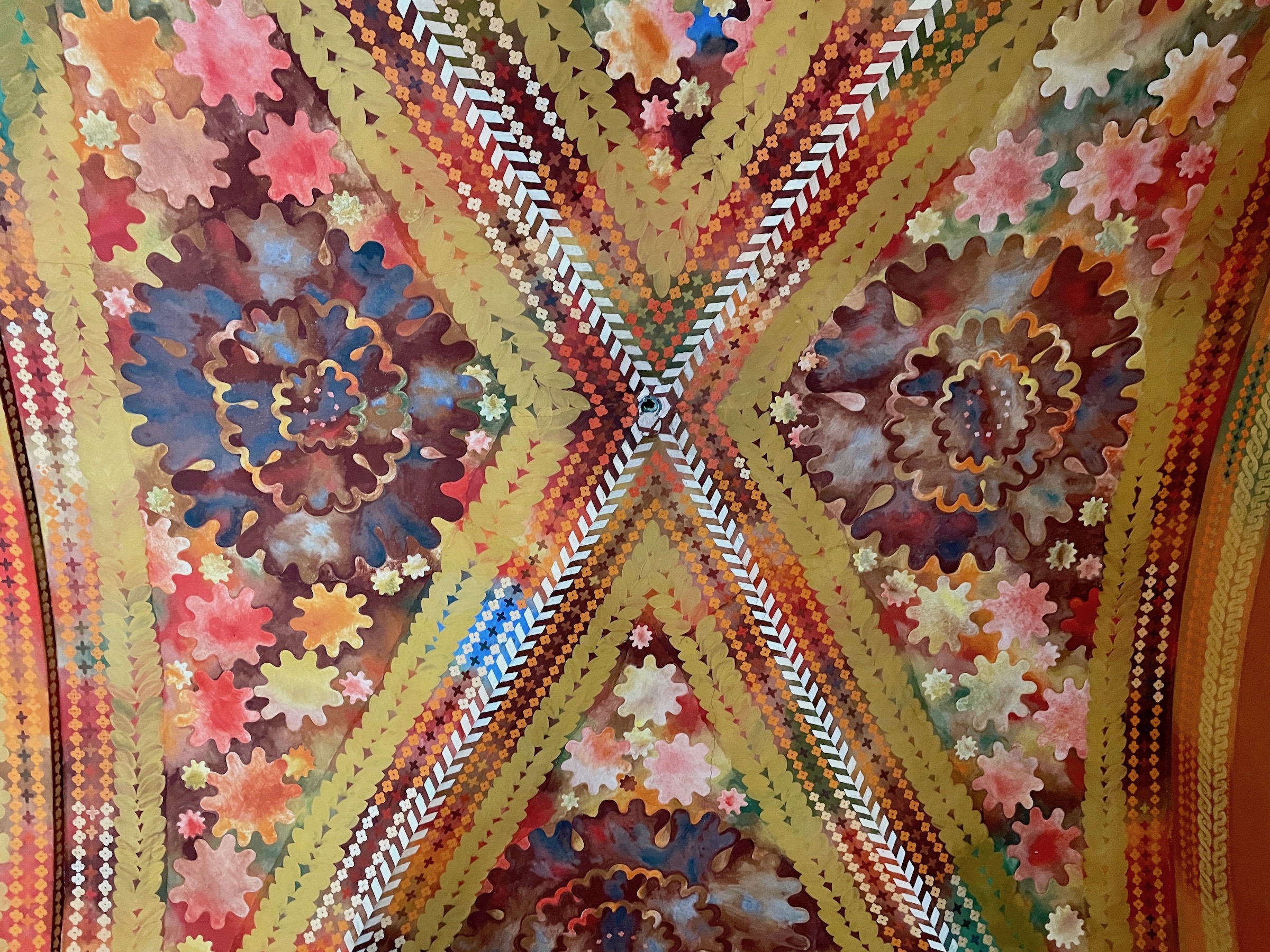
And a series of ghostly images on the walls.
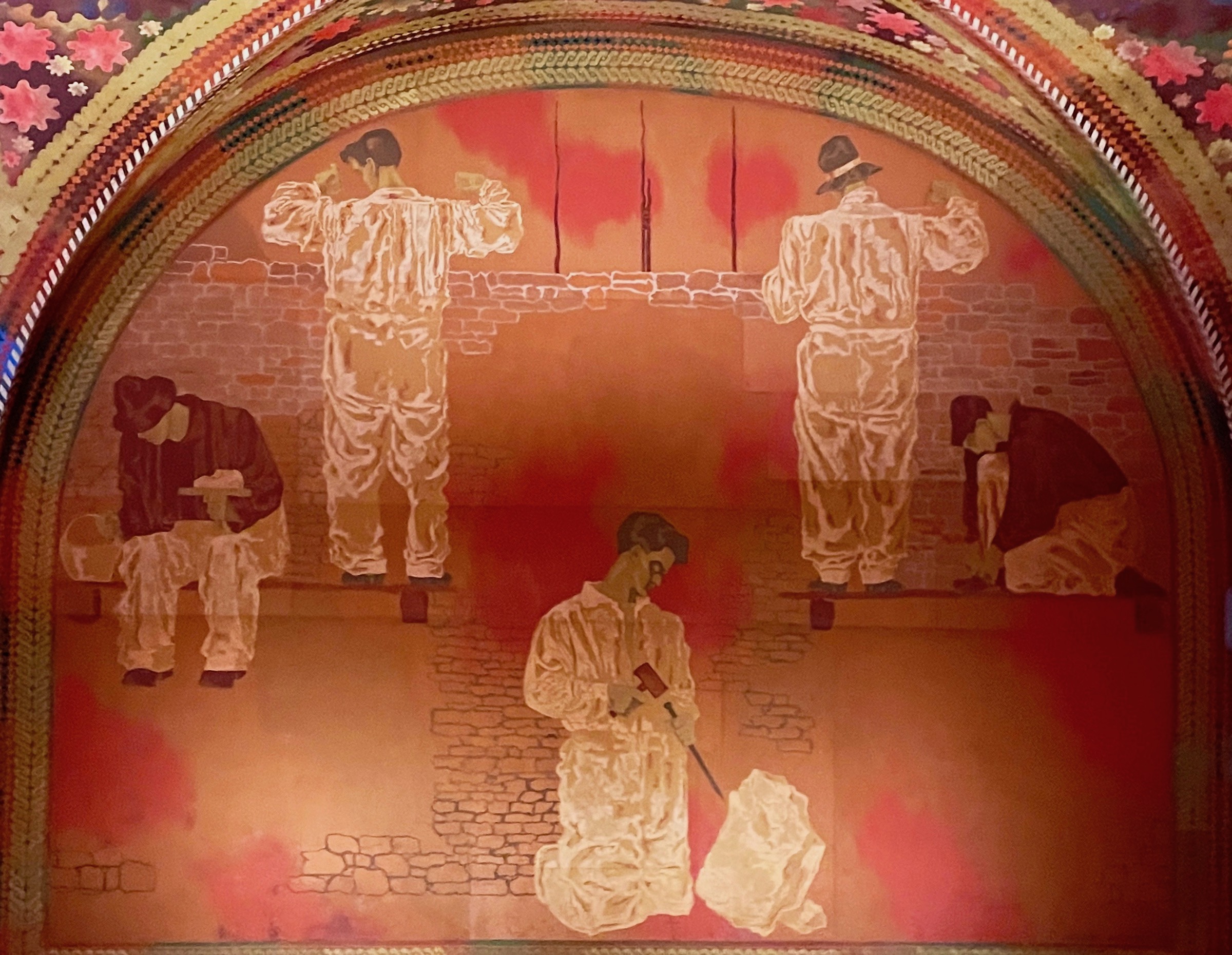
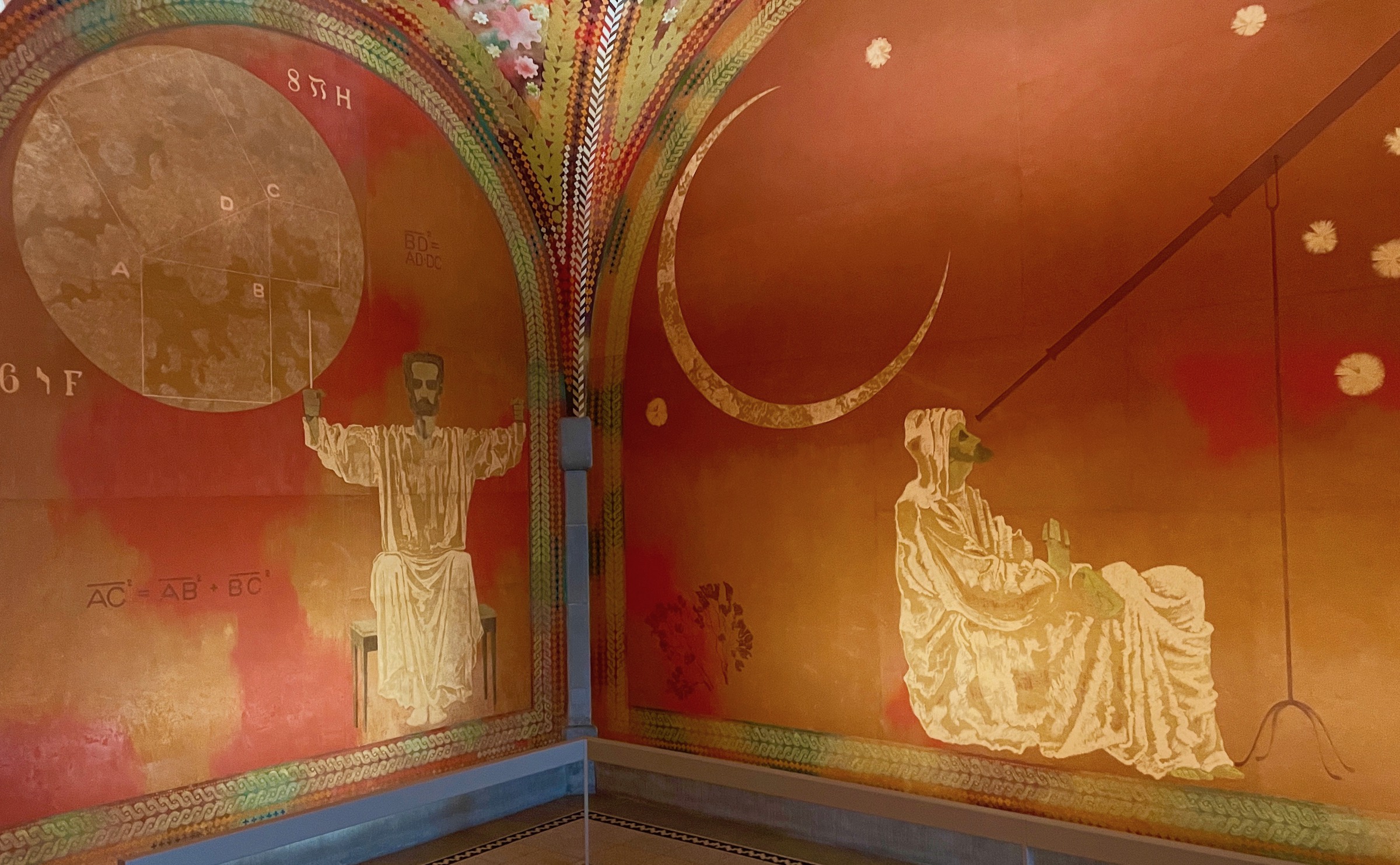
It is clear that the Swiss or at least the people of Zurich don’t believe that a police station interior need be dreary or a place of fear for many.
From here we made our way to the Lindenhof, a hill that overlooks the Limmat River and is the oldest part of the city. The Romans built a fort here that lasted hundreds of years until supplanted by a Carolignian palace in the 9th century. Both are long gone and now the area is a park which has the best views in Zurich.
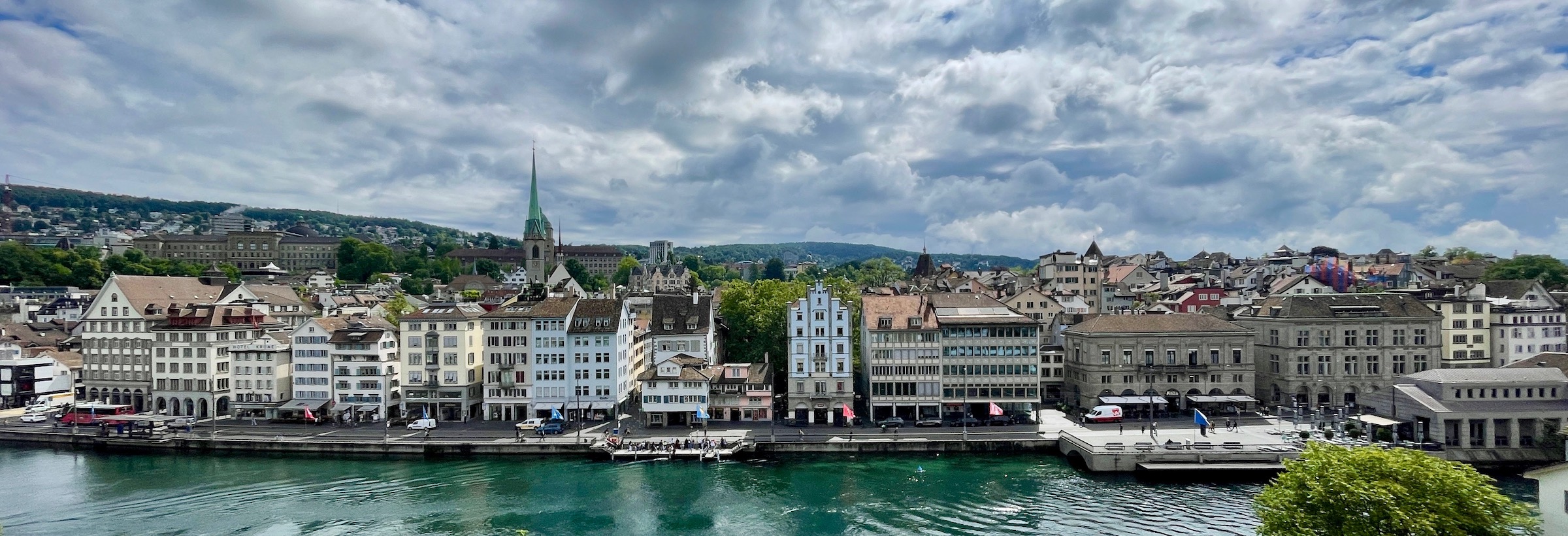
This is the view looking toward the Grossmünster which we will visit later on this walk.
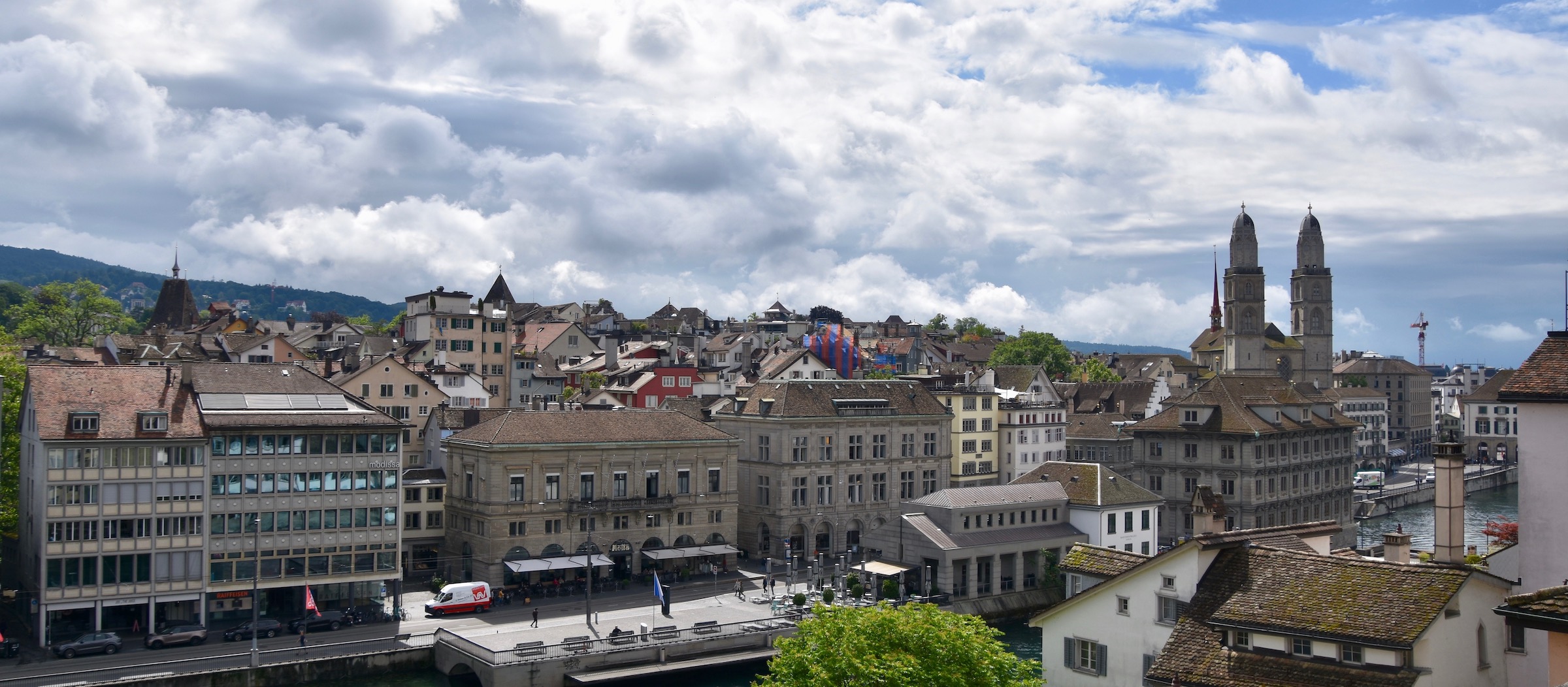
Looking to the left there is a view of the Predigerkirche, one of the four main churches of Zurich.
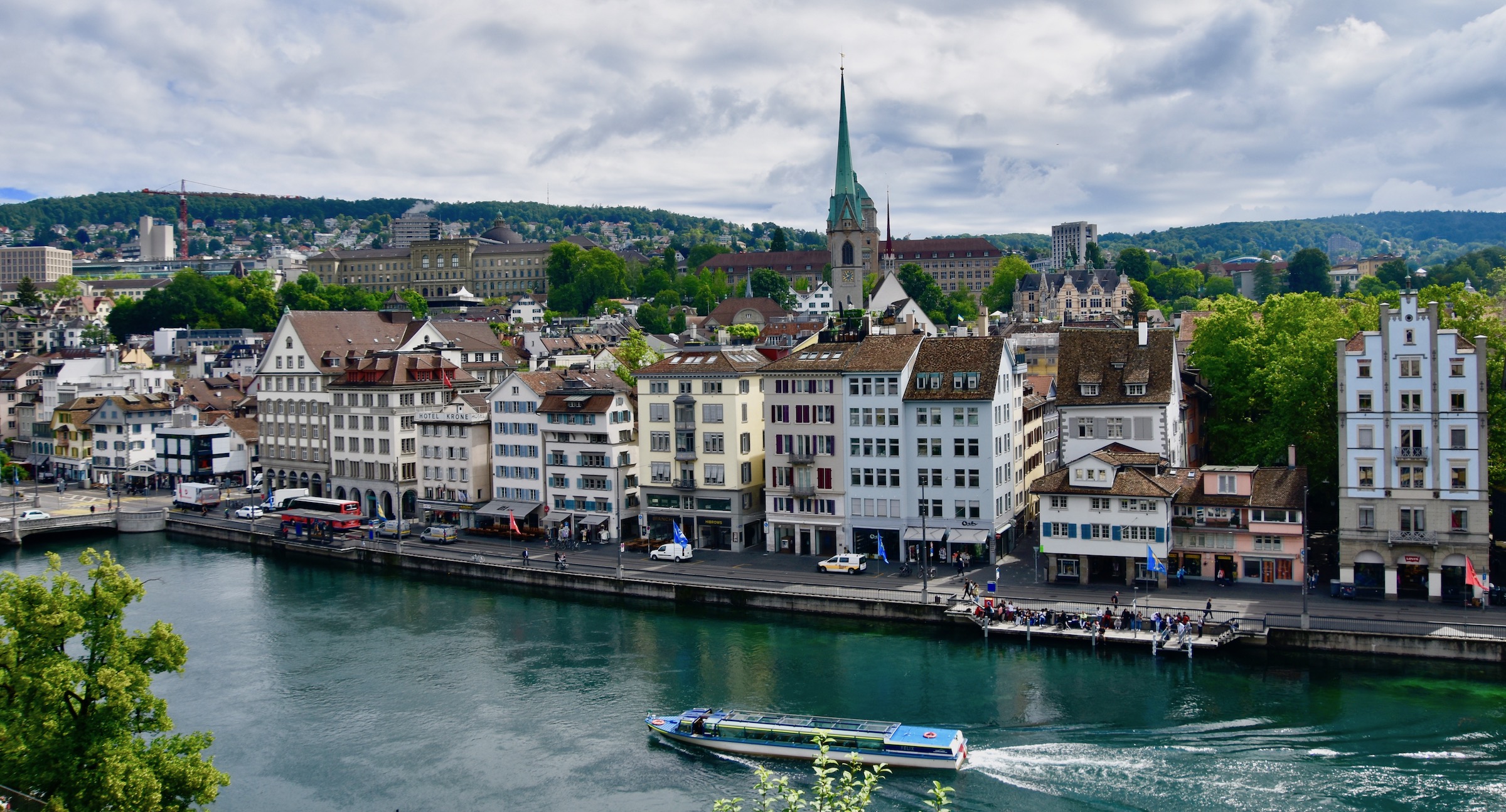
Also on this side is the Swiss Federal Institute of Technology (ETH) from where Albert Einstein earned his degree in mathematics and natural sciences in 1900. He later had several stints as a professor, No less than eight graduates from this institution have won the Nobel Prize for Physics, including Einstein and Wilhelm Röntgen, the discoverer of the X-ray.
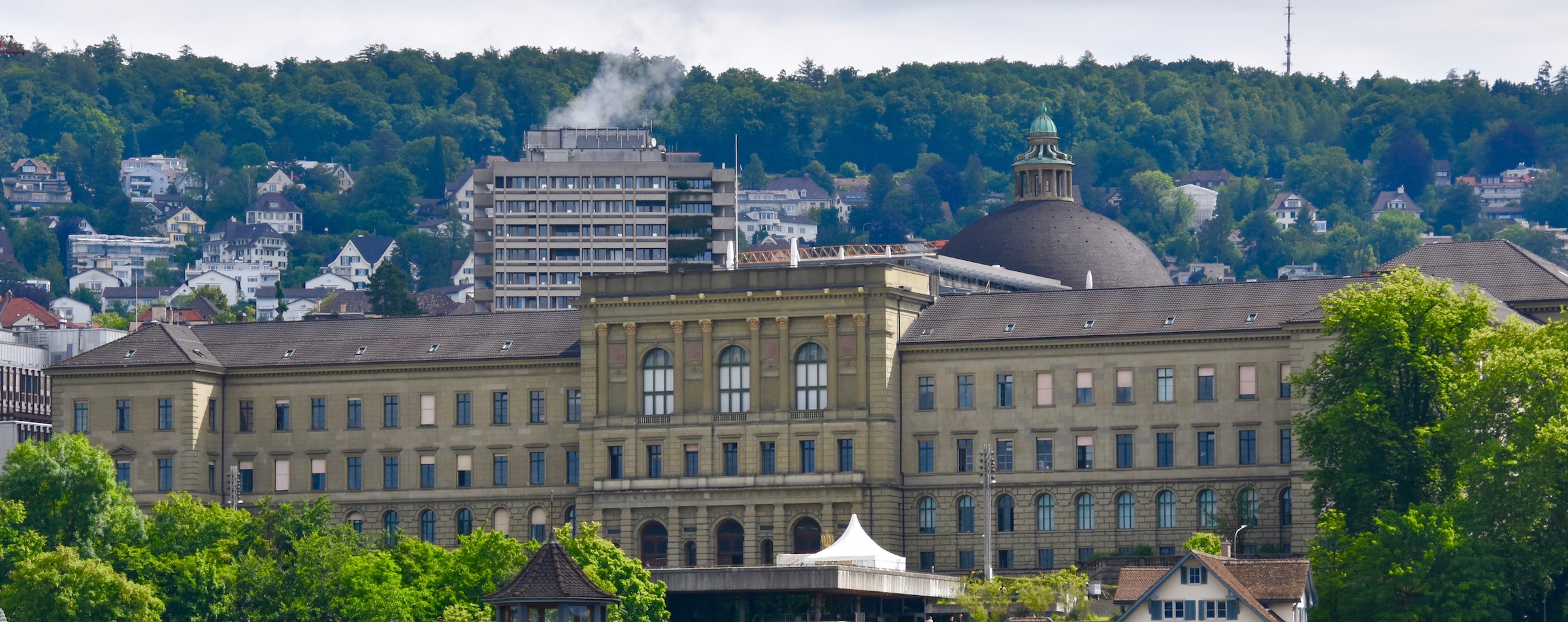
Walking down from the Lindenhof we come across a remnant of Roman Zurich or Turicum as it was then known, in this tombstone of a child.
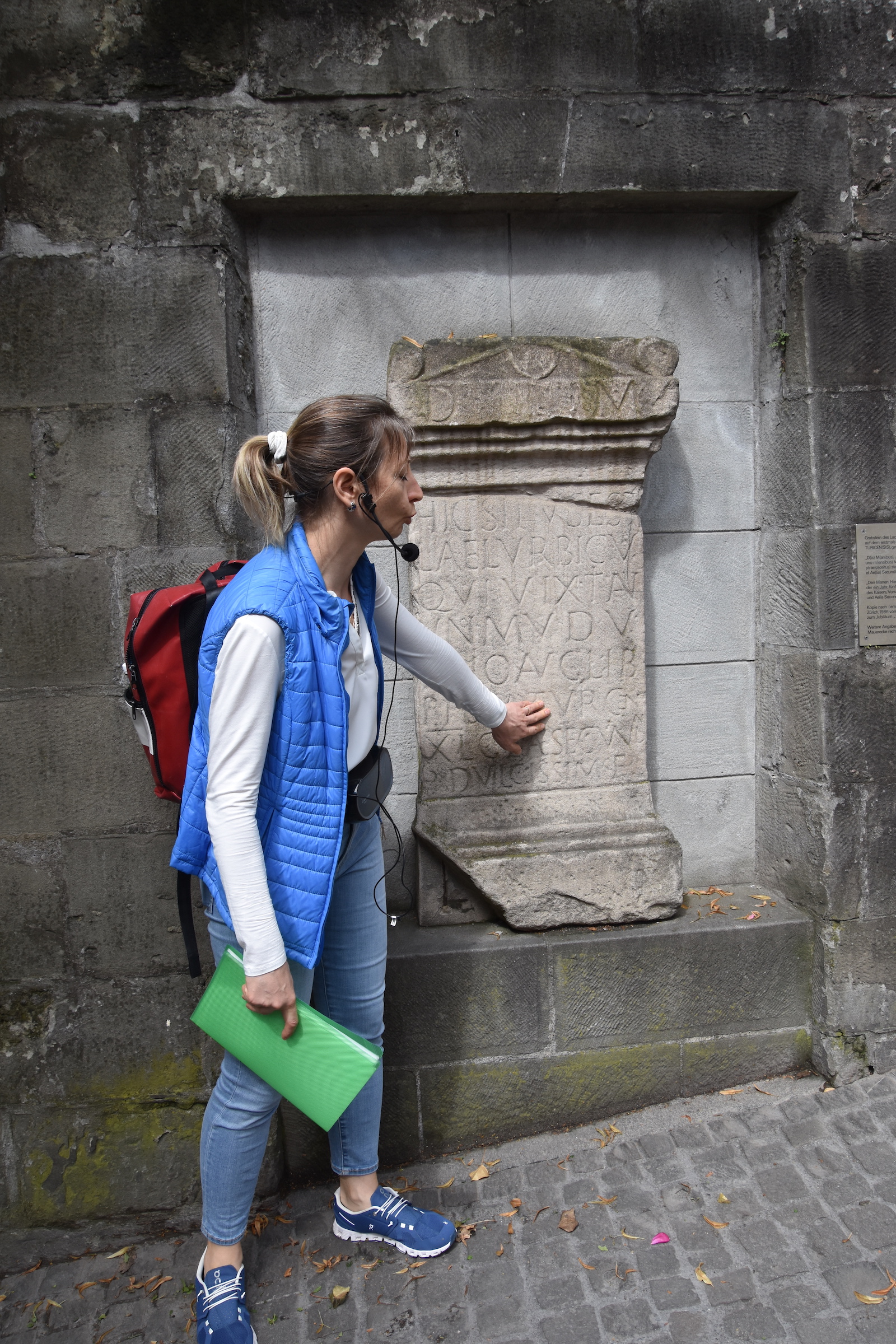
This next stopping point is not on most standard walking tours of Zurich. Alla asks us to guess what it is and after a number of wrong answers, someone gets it right. It’s a cat’s ladder and has been used for ingress and egress from a fourth story apartment for Felix for many years. Apparently cat ladders are a thing in Switzerland.
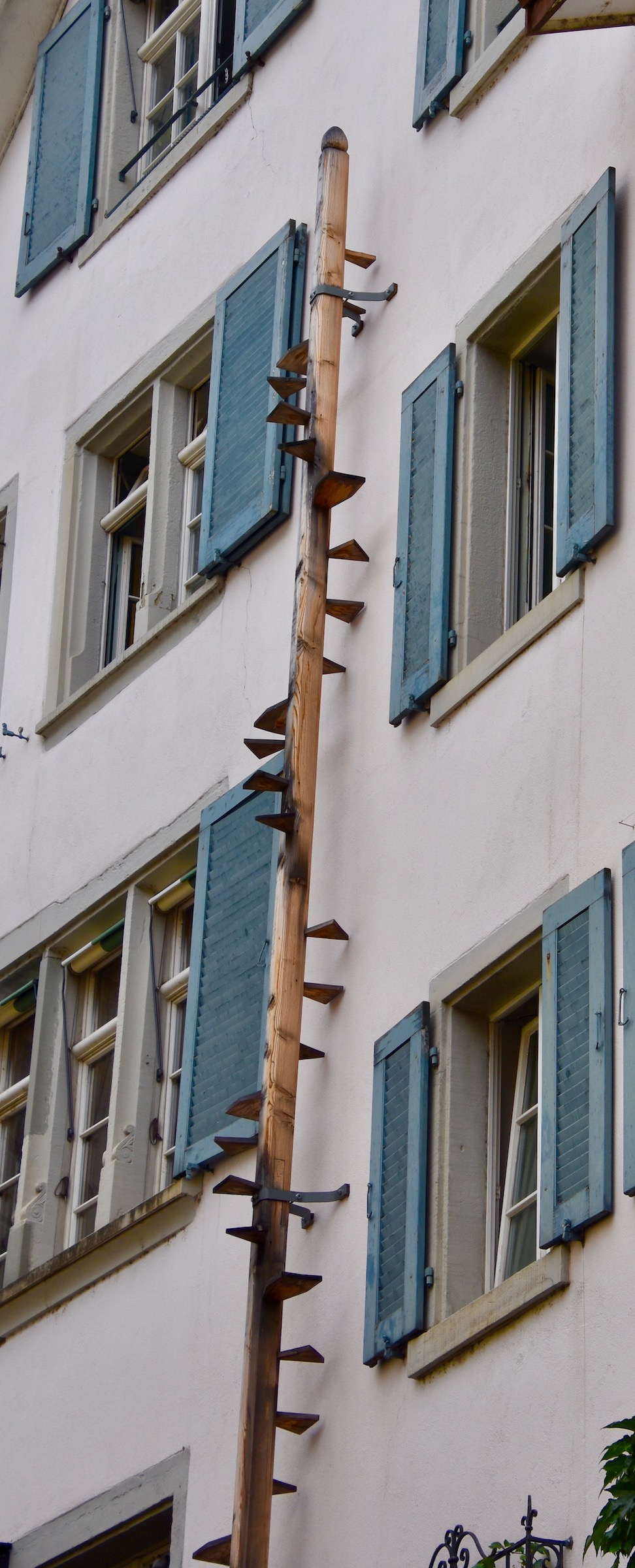
We are now in a very posh area of Zurich with many fine shops that have very photogenic exteriors.
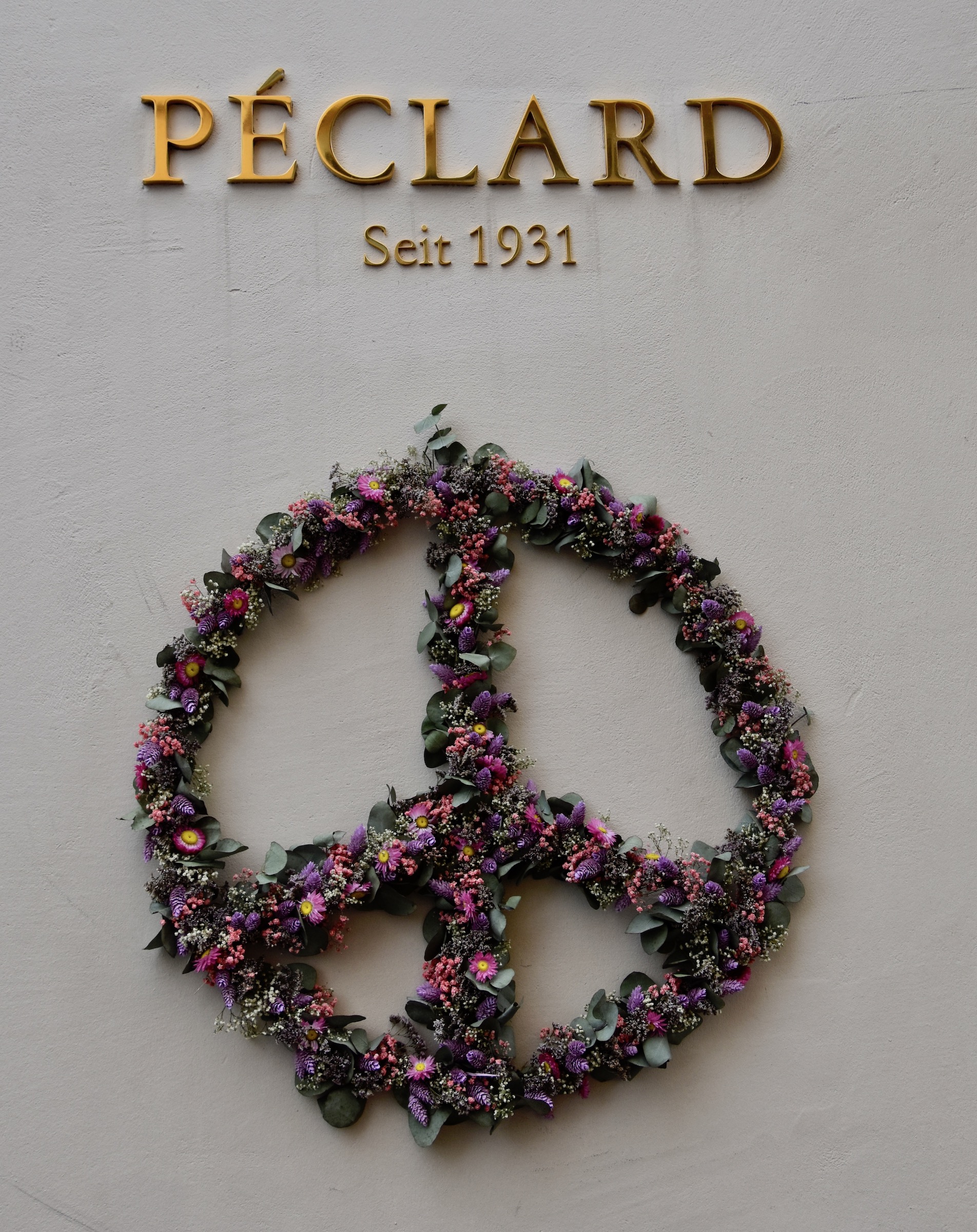
Alla points out that before the street numbering system, which we take for granted, existed, houses were usually distinguished by their names such as this one, House of the Bell.
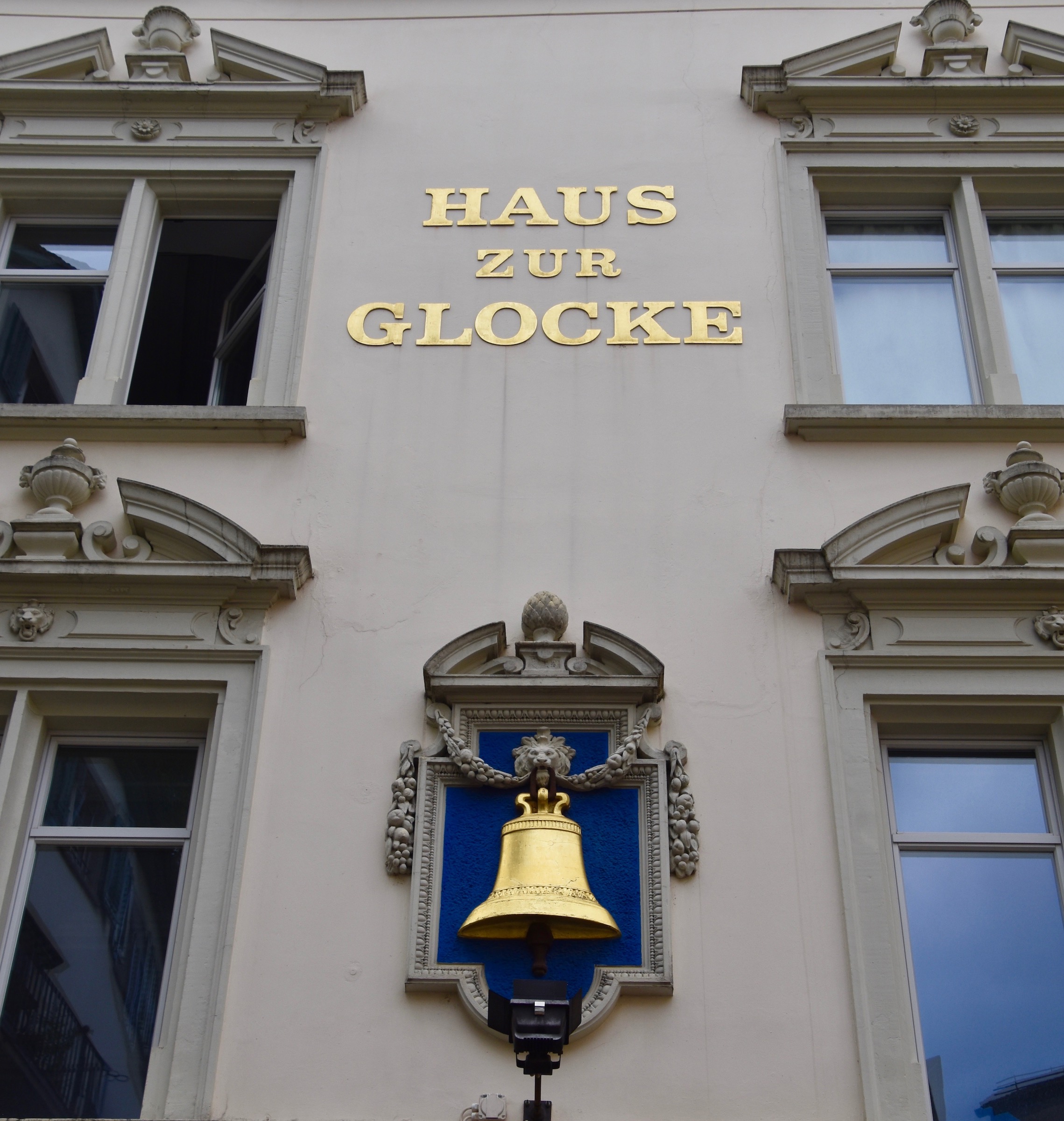
Another of the four famous churches of Zurich comes into view on this side of the Limmat. This is the Church of St. Peter, the oldest parish in the city with earlier churches on site going back to the 8th century and built on top of a Roman temple. It’s present day claim to fame however is not its age but rather its clock face which is the largest in Europe.
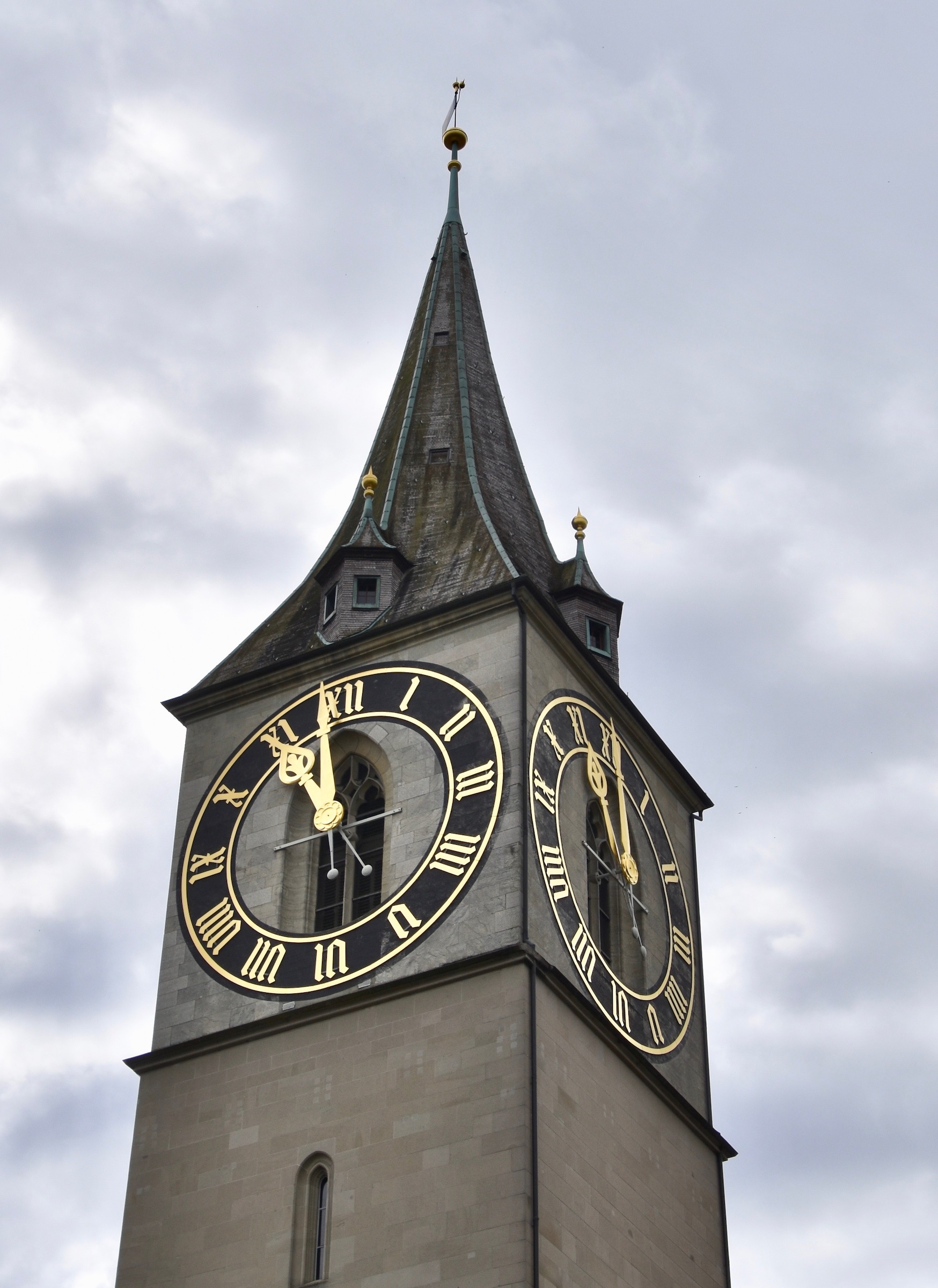
Continuing on we pass another example of house description with this golden key.
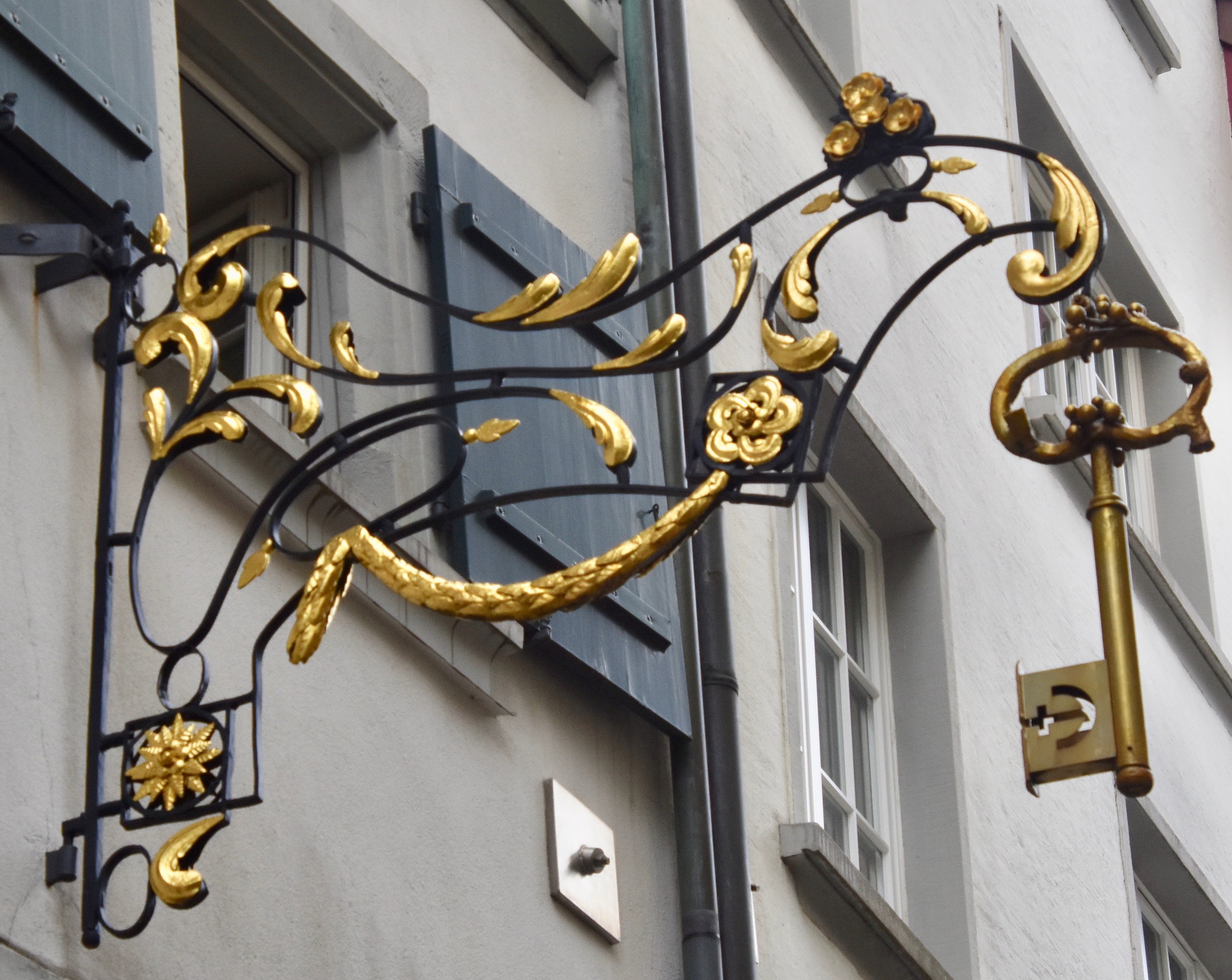
And yet another dating all the way back to 1357.

Inside a short pedestrian tunnel this interpretive panel tells us we are on the site of an ancient Roman bath system.
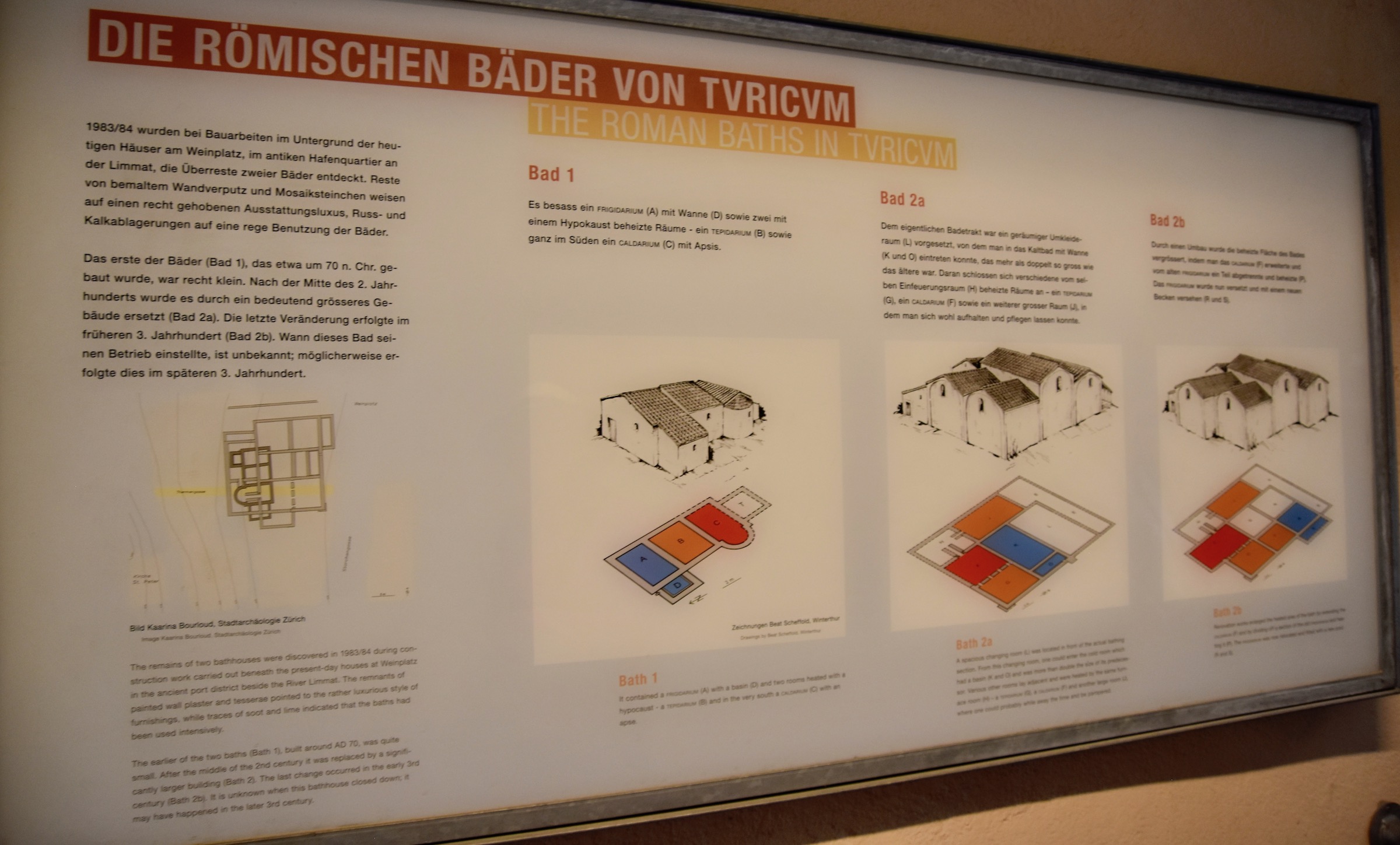
Next we get a view of the Zurich town hall or rathaus with its clear Renaissance influenced architecture. This was built in the 17th century and houses both the city and the canton’s governing bodies.
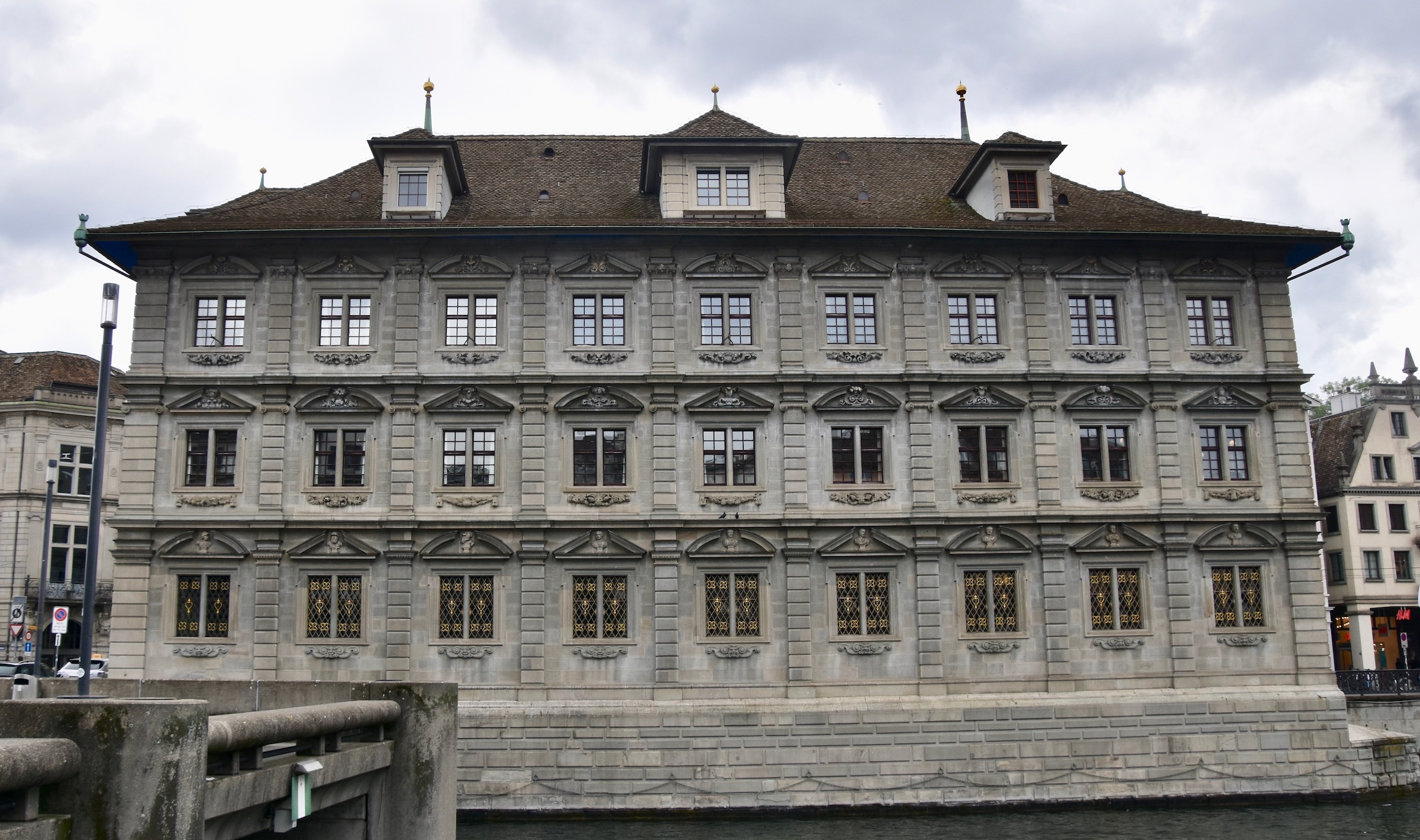
Crossing the Limmat on the Münsterbrücke I did a double take looking back at this apparent stork’s nest.
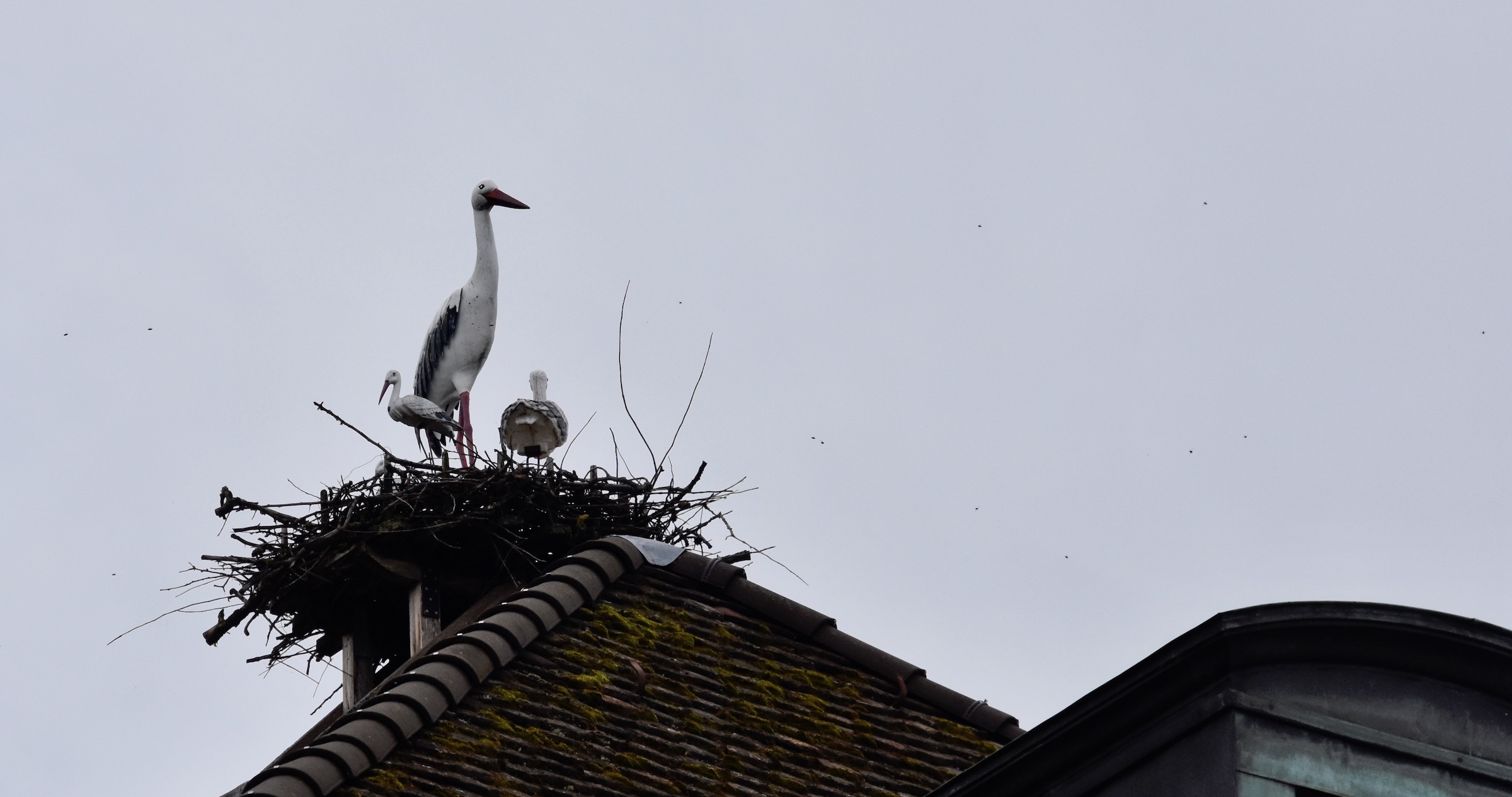
It’s actually a wooden model atop the Hotel Storchen which has roots as far back as 660 years and has hosted Paracelsus, Richard Wagner and American novelist John Irving who has included it in a couple of his stories.
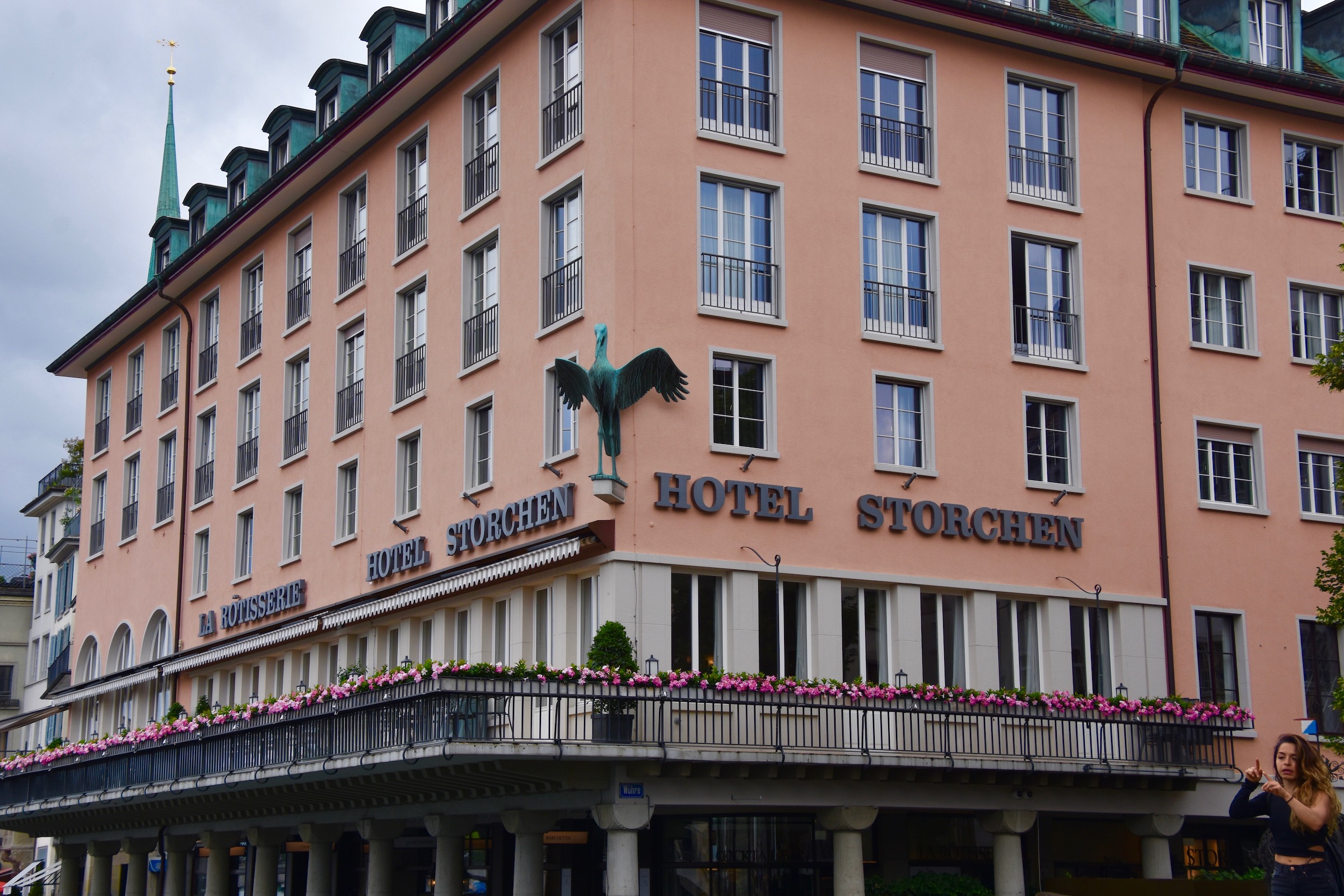
From the bridge we also get a look at the Fraumünster, the fourth of the famous four and where we will end the tour.
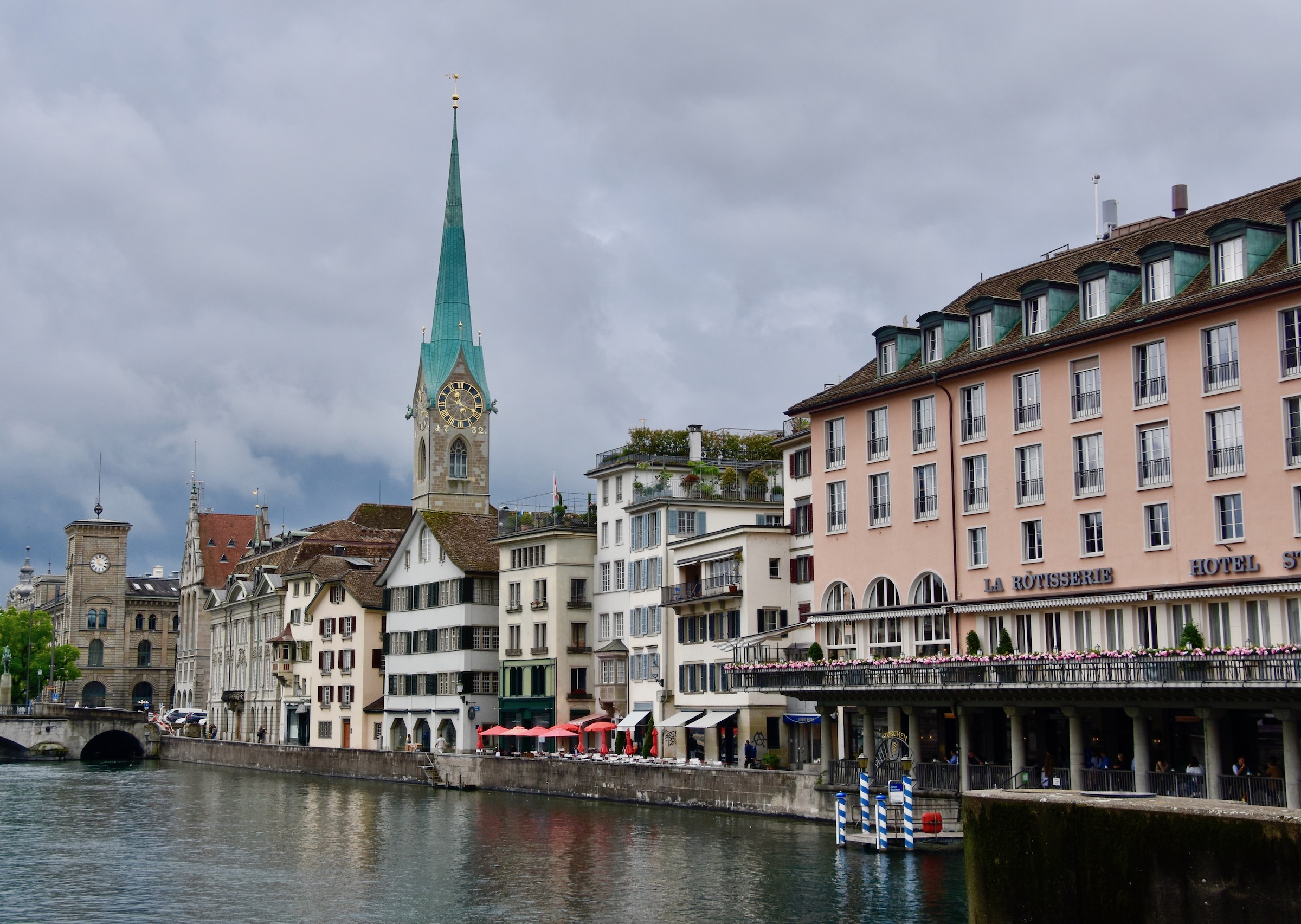
We are now back on the side of the Limmat where we started the tour and into an area of many restaurants and shops all of which seem to have interesting signage of one sort or another.
This one is advertising a beer hall.
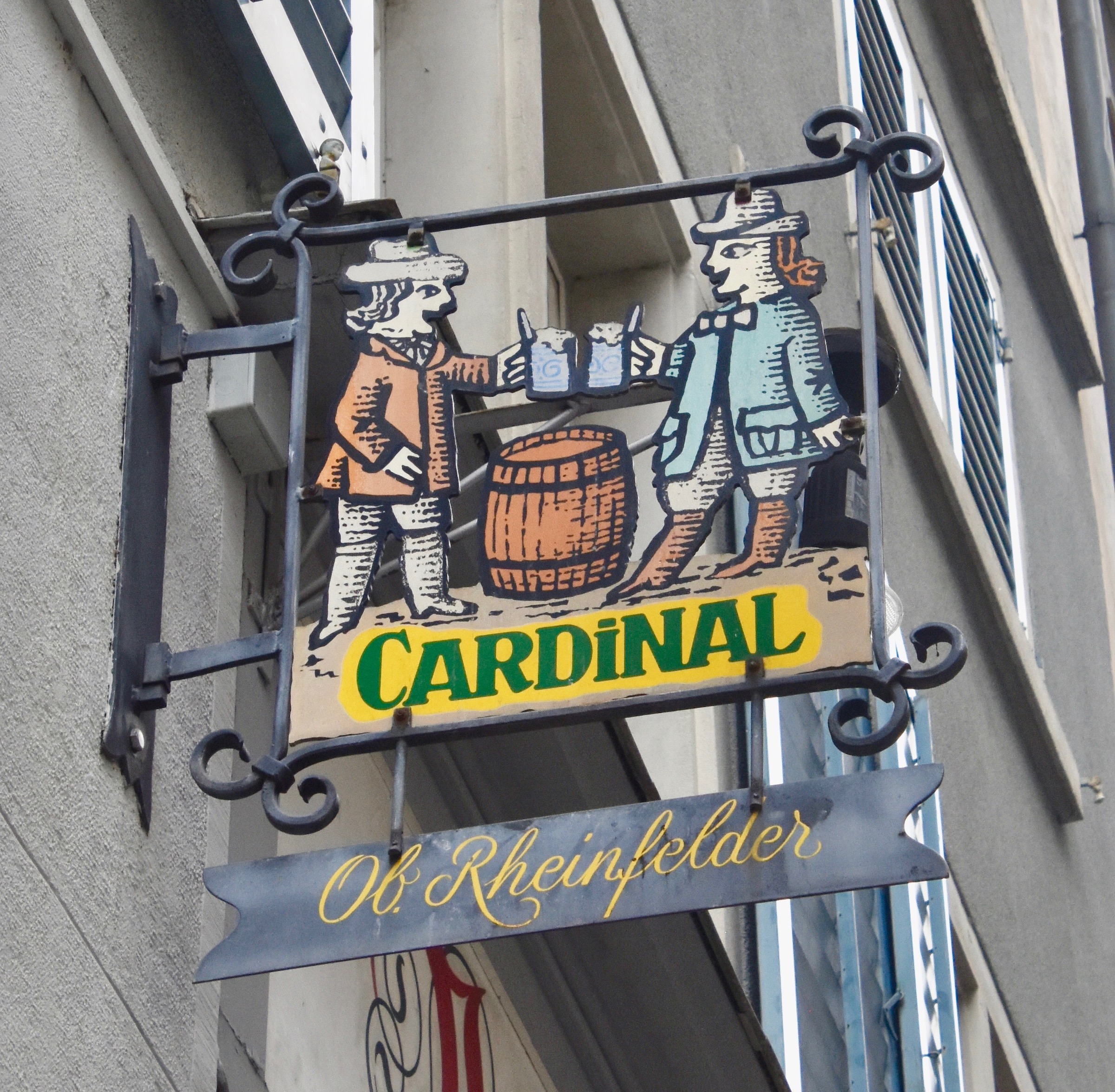
This one is particularly intriguing, incorporating a number of heraldic symbols adding up to what, I don’t have a clue.
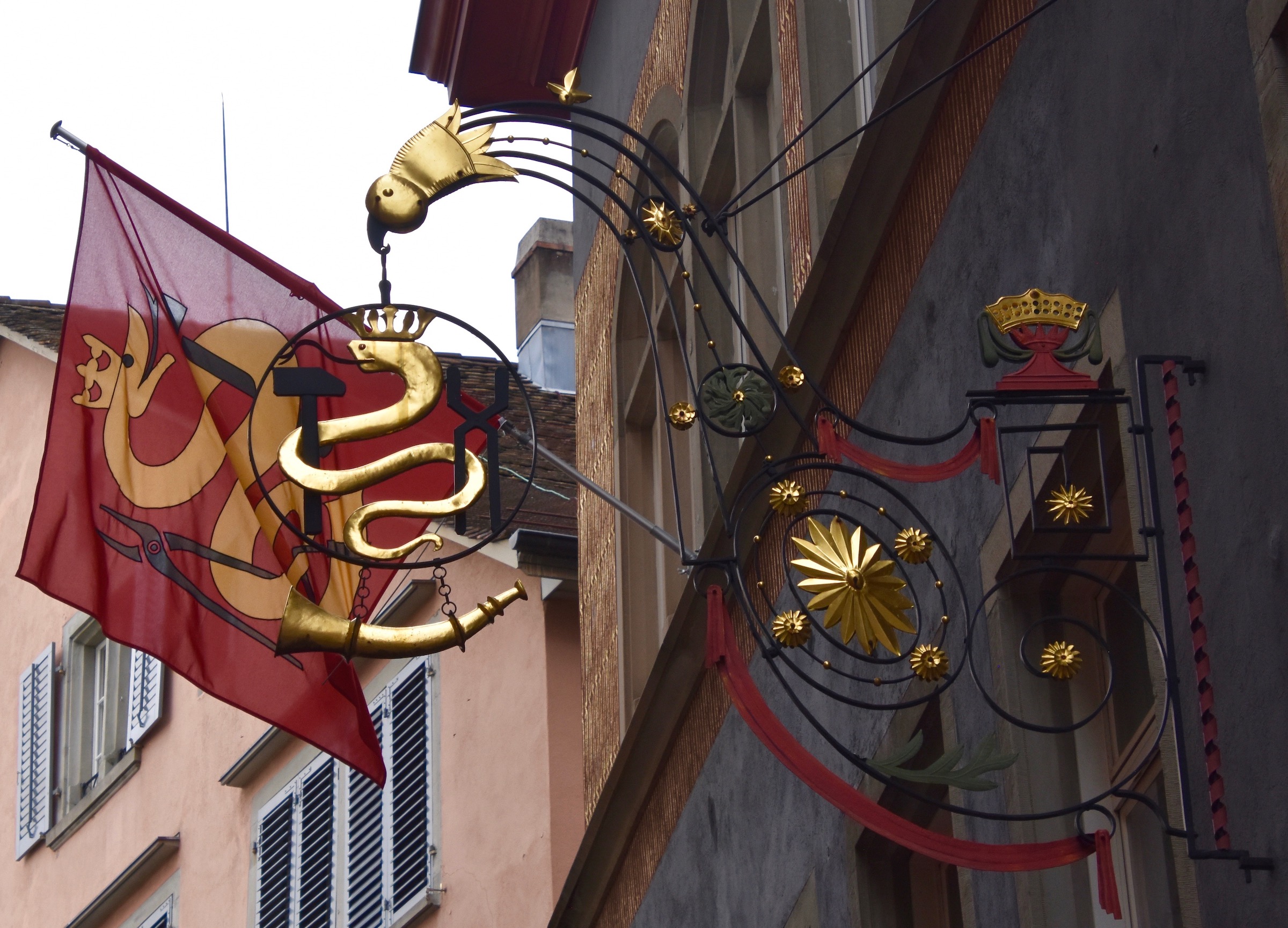
Next the Oepfel-Chammer restaurant which has been feeding hungry guests since 1801.
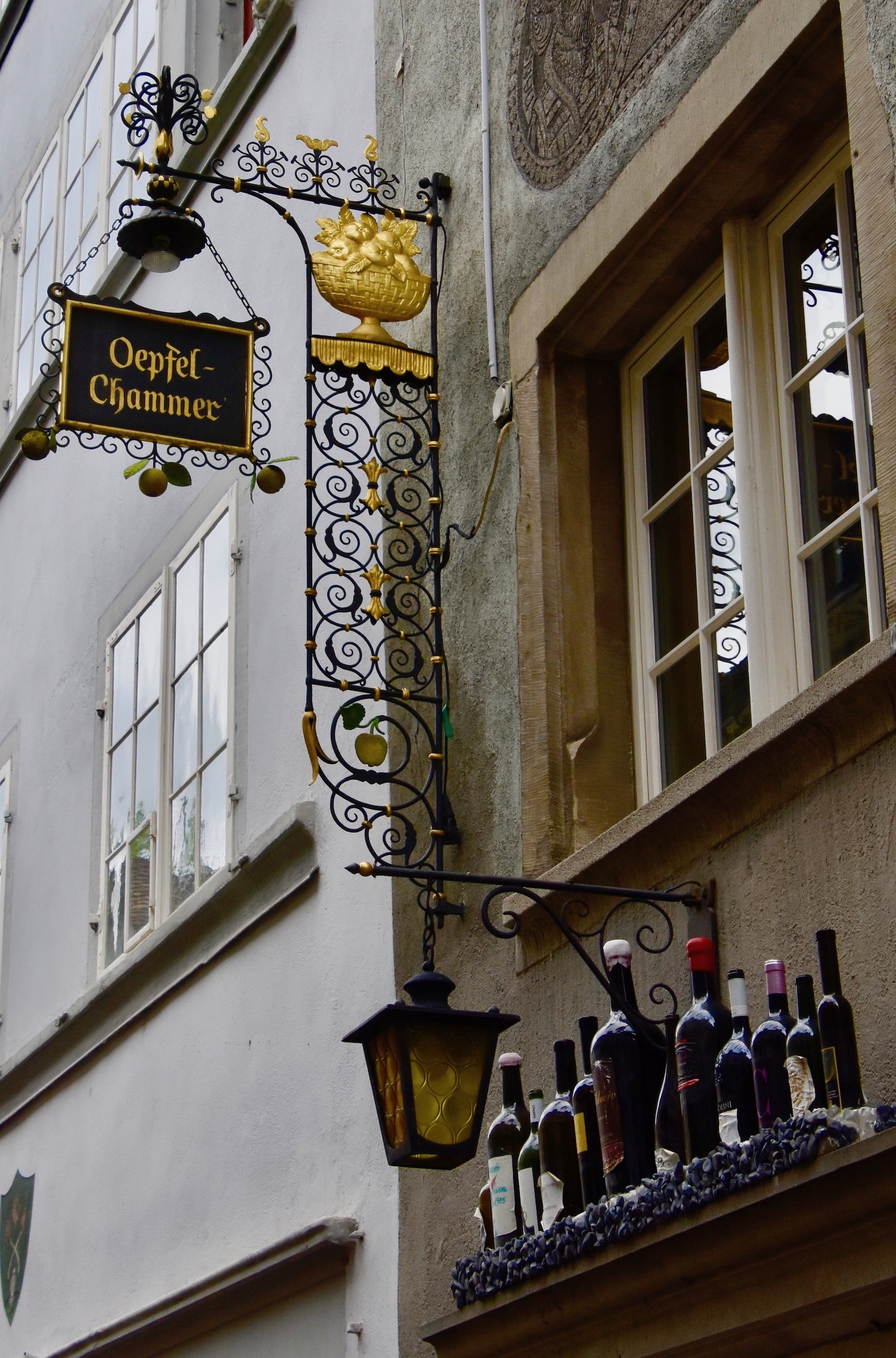
At a small gated park Alla points out a statue of a famous cat that once kept the area free of mice and rats.
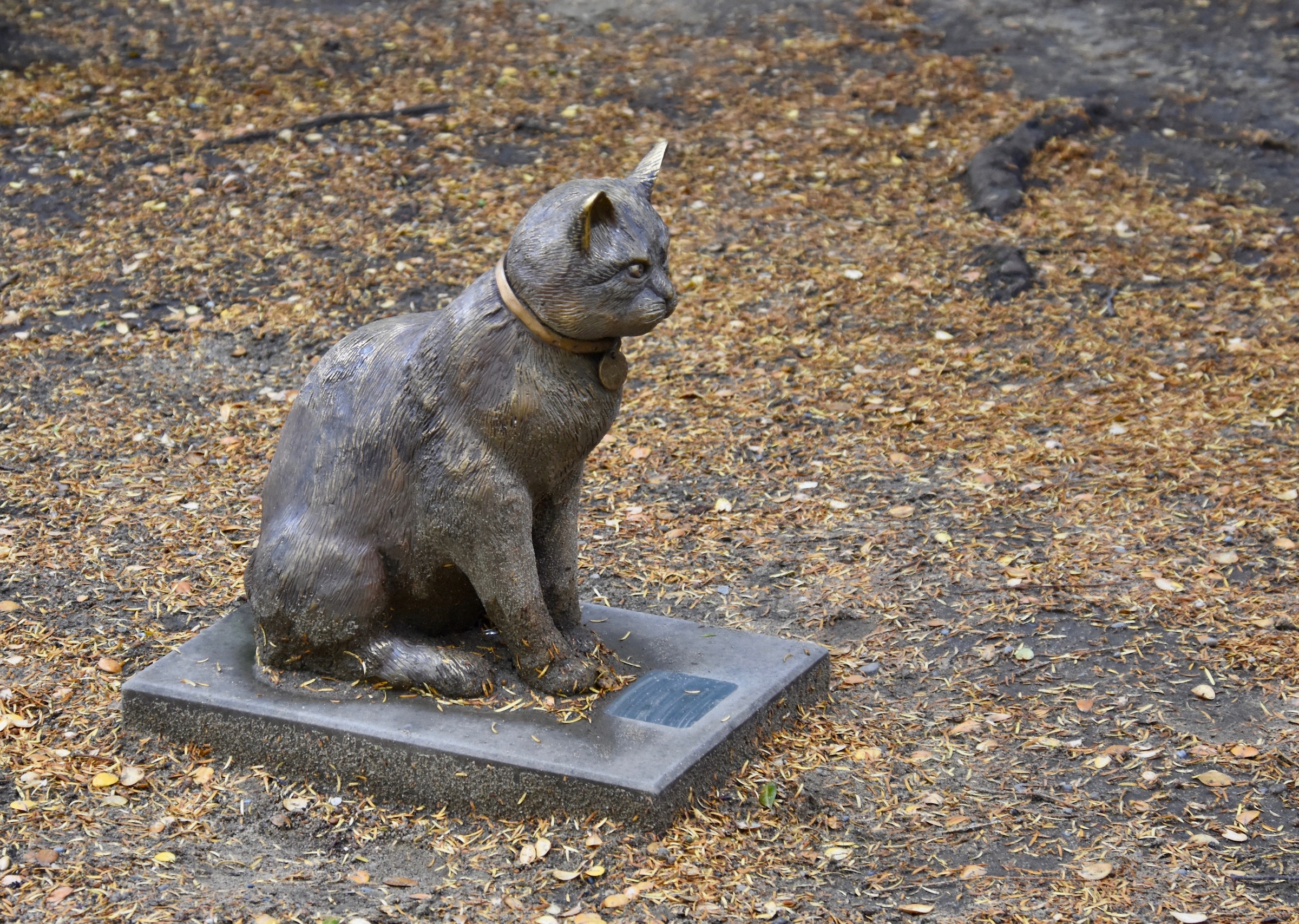
Next we come to what might be the historically most important place on the tour. This is the apartment where Vladimir Lenin lived. After fleeing Russia in 1914 he settled in Geneva, then Bern and finally here. In a brilliant move that directly affected world history, the Germans transported him from here back to St. Petersburg in 1917 where he became the leader of the revolution that led to the rise of Communism with all its subsequent horrors for the Russian people. It also caused the Russian army to collapse and sue for peace with Germany, enabling the war on the Western Front to go on for another year and a half.
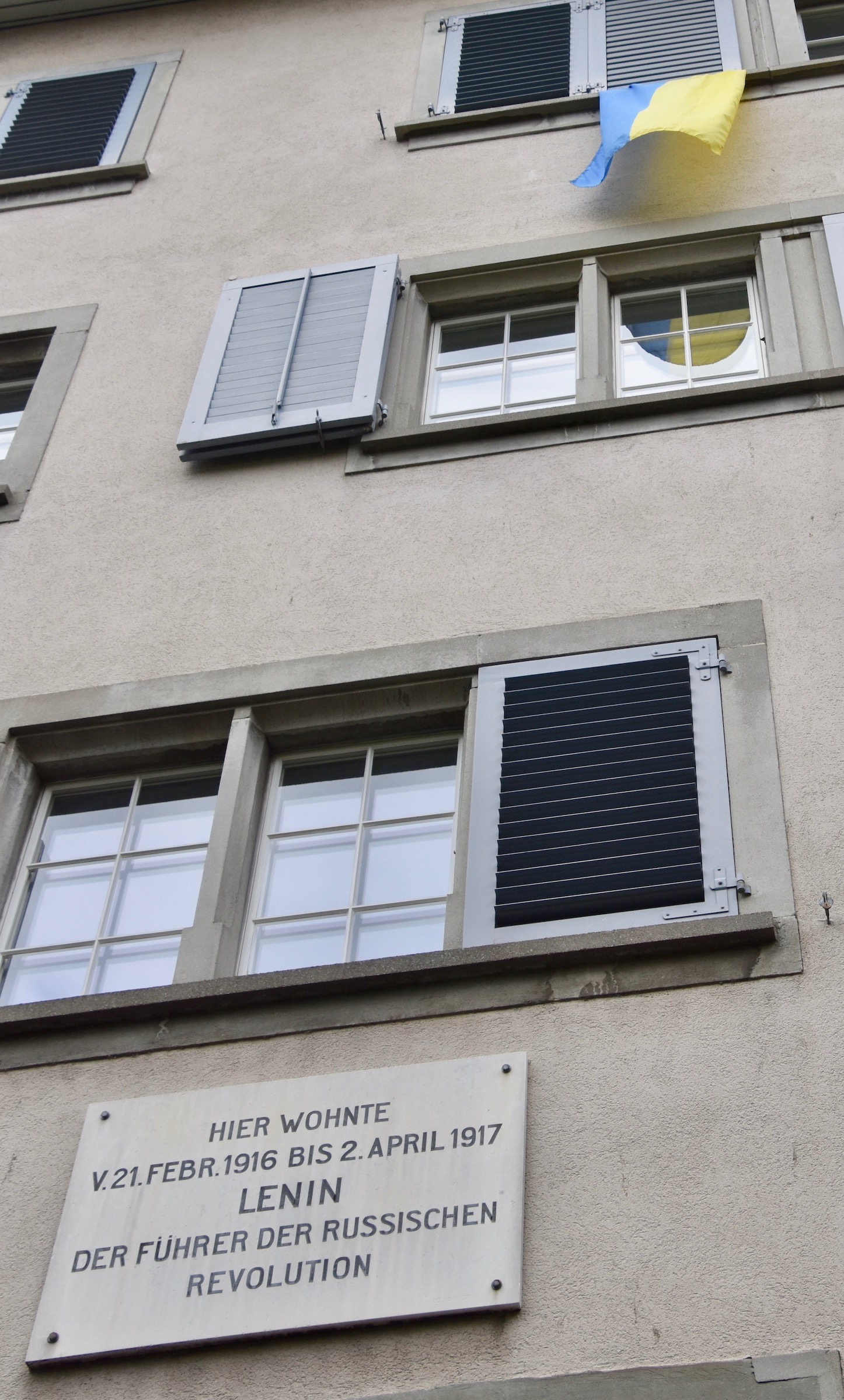
What delicious irony that a Ukrainian flag now flies over the Lenin apartment.
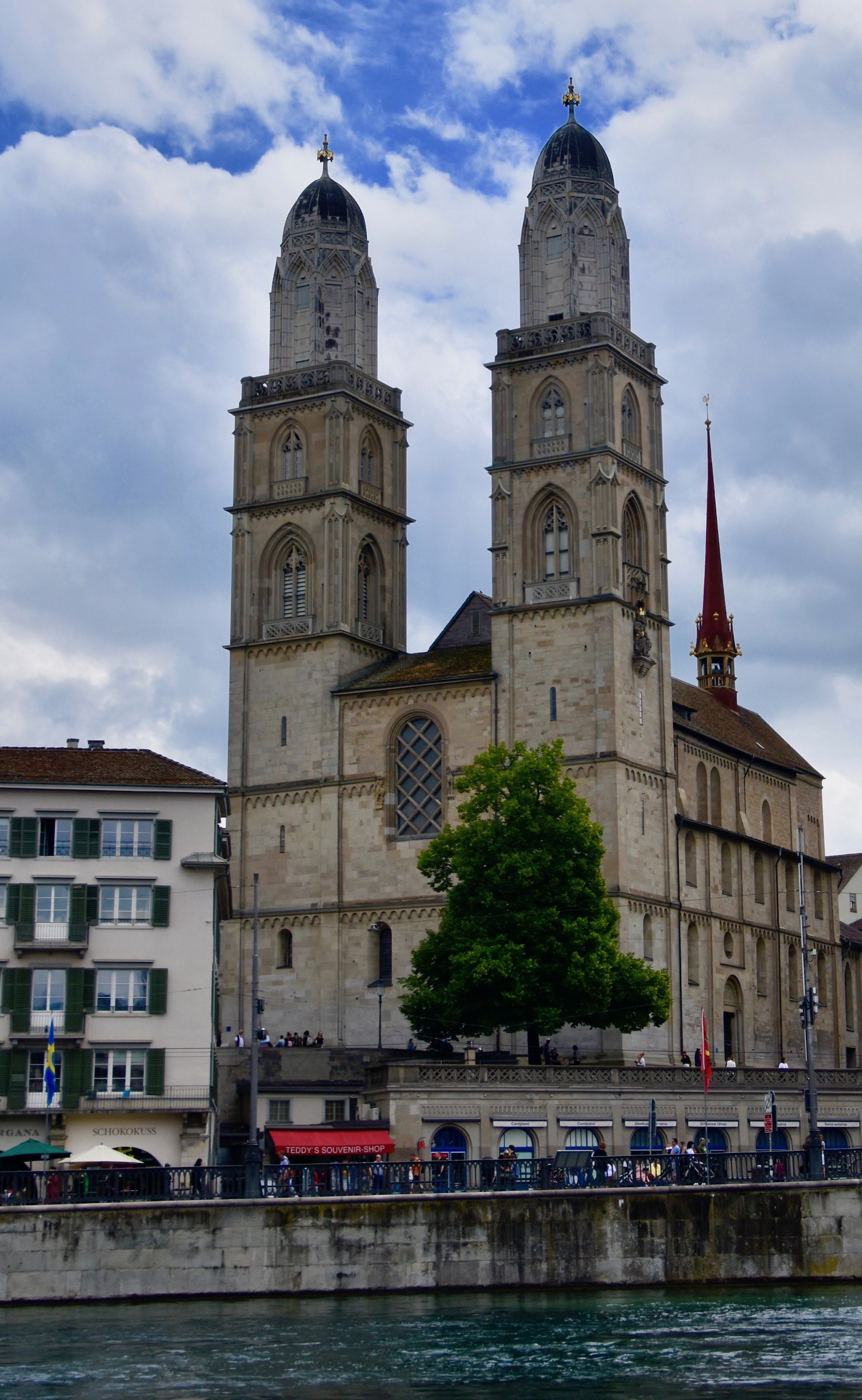
Our group was now approaching the Grossmünster which claims to have been erected on a site chosen by Charlemagne. It took over a century to build between 1100 and 1220. If you look up at the south tower you can see the legendary king of the Carolingians enthroned there. The actual tops of the two spires were not completed until 1797, replacing earlier versions destroyed by fire. I must admit that Zurich’s Grossmünster is not the prettiest church to look at and tend to agree with Richard Wagner who compared the towers to two pepper grinders.
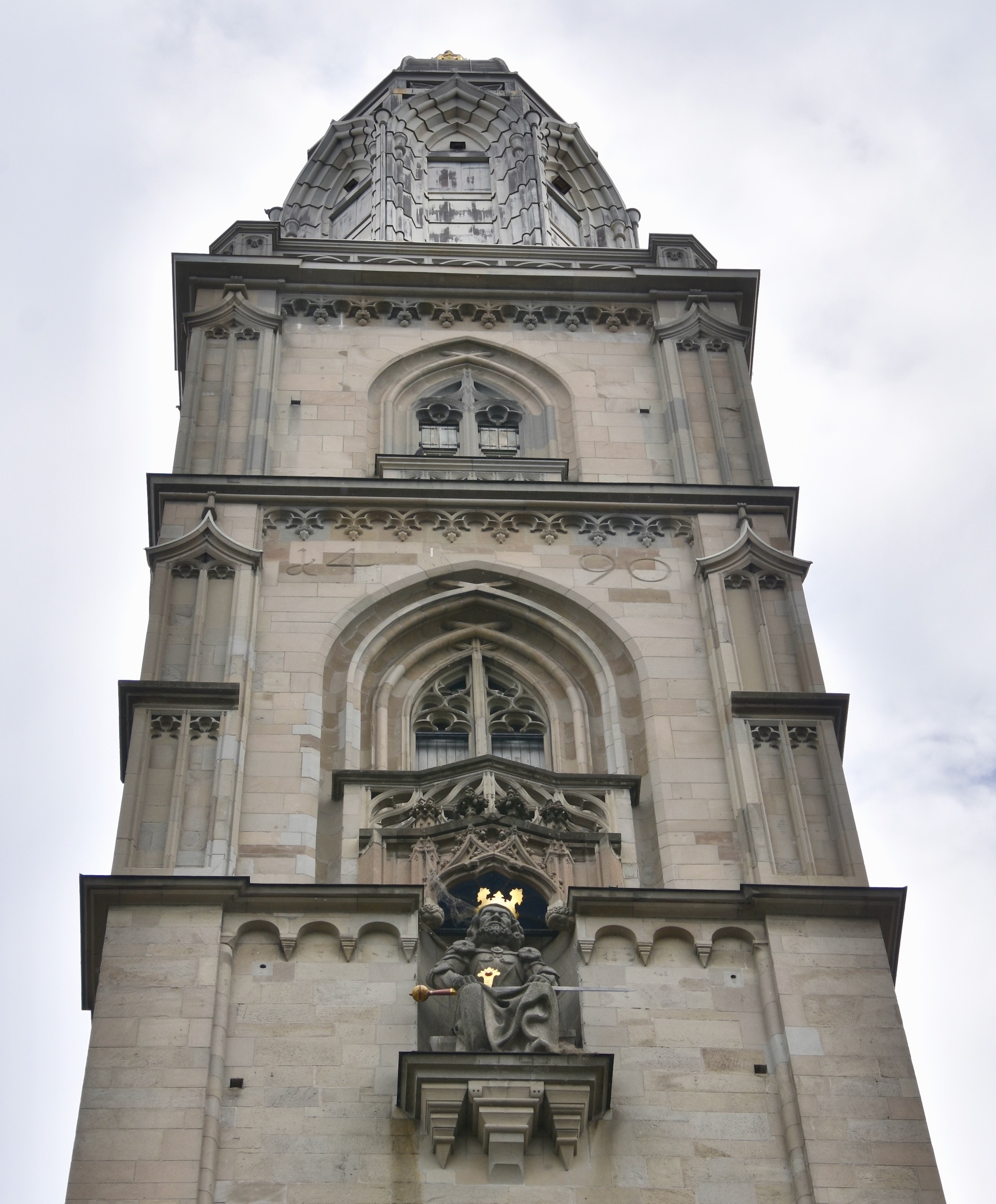
The Grossmünster is historically important for its role in the Reformation as it was the church presided over by Zwingli who railed against the papacy and succeeded in convincing the city elders to break with it in 1523.
The Grossmünster has many modern additions which have softened the dour interior which the reformers favoured. Among these are a series of stained glass windows by Augusto Giacometti whose work we saw in the police station and another series by the German artist Sigmar Polke. This agate based window was only added in 2009, a year before the artist’s death. Totally abstract, it is a joy to view.
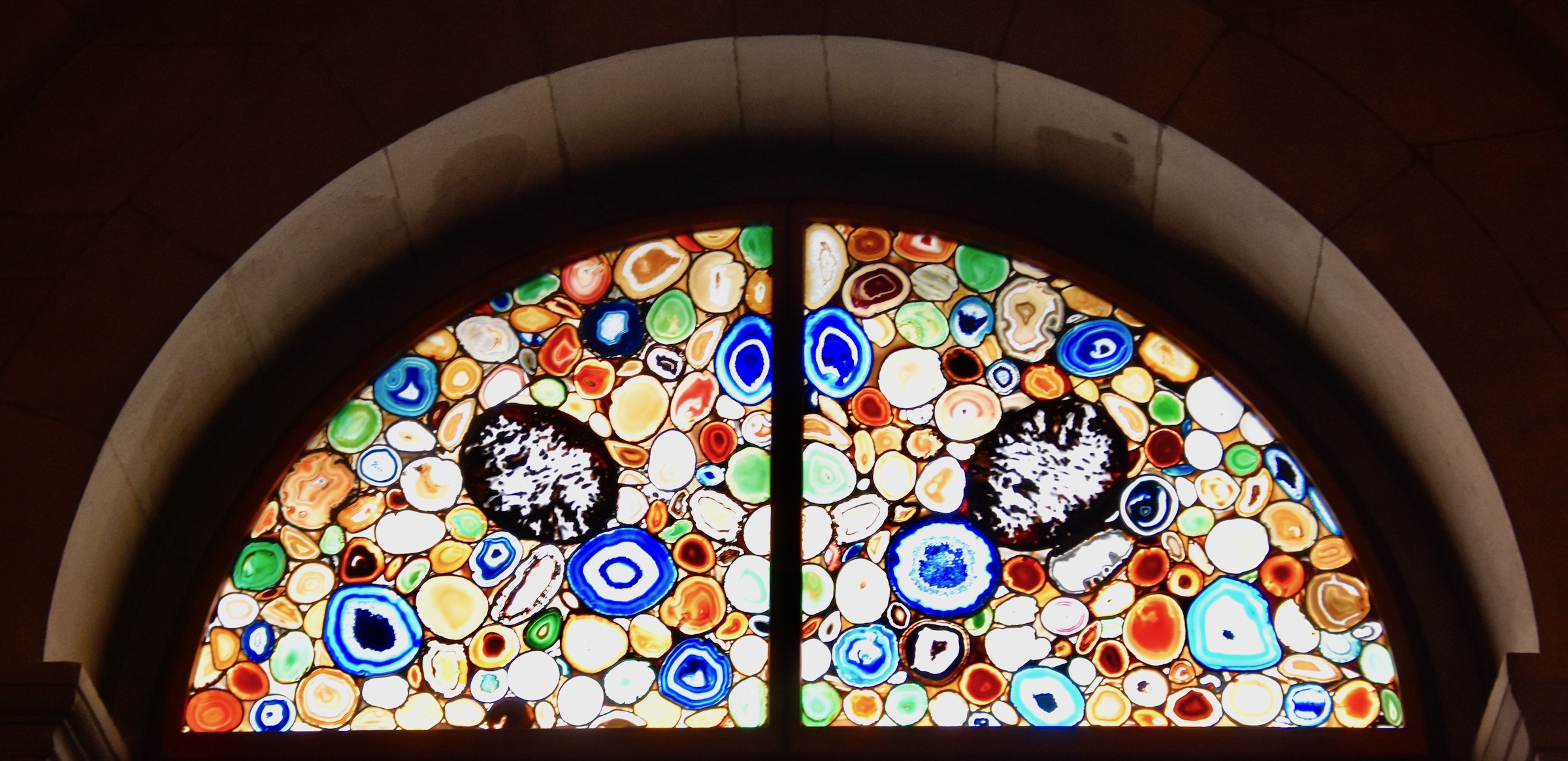
Polke also did some of the more typical type of stained glass, portraying scenes from the Bible such as this one featuring King David.
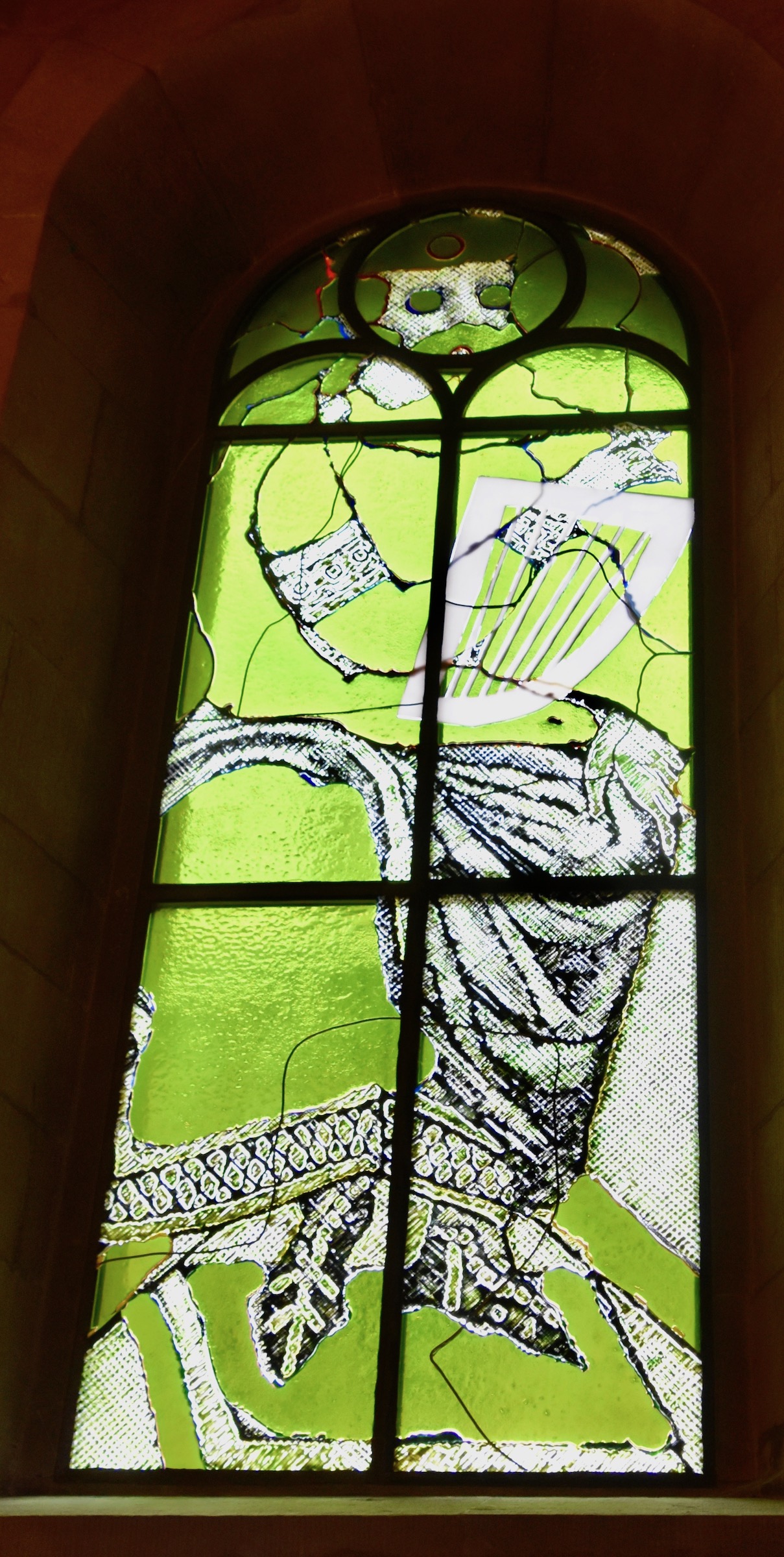
The prophet Elijah with his chariot of fire.
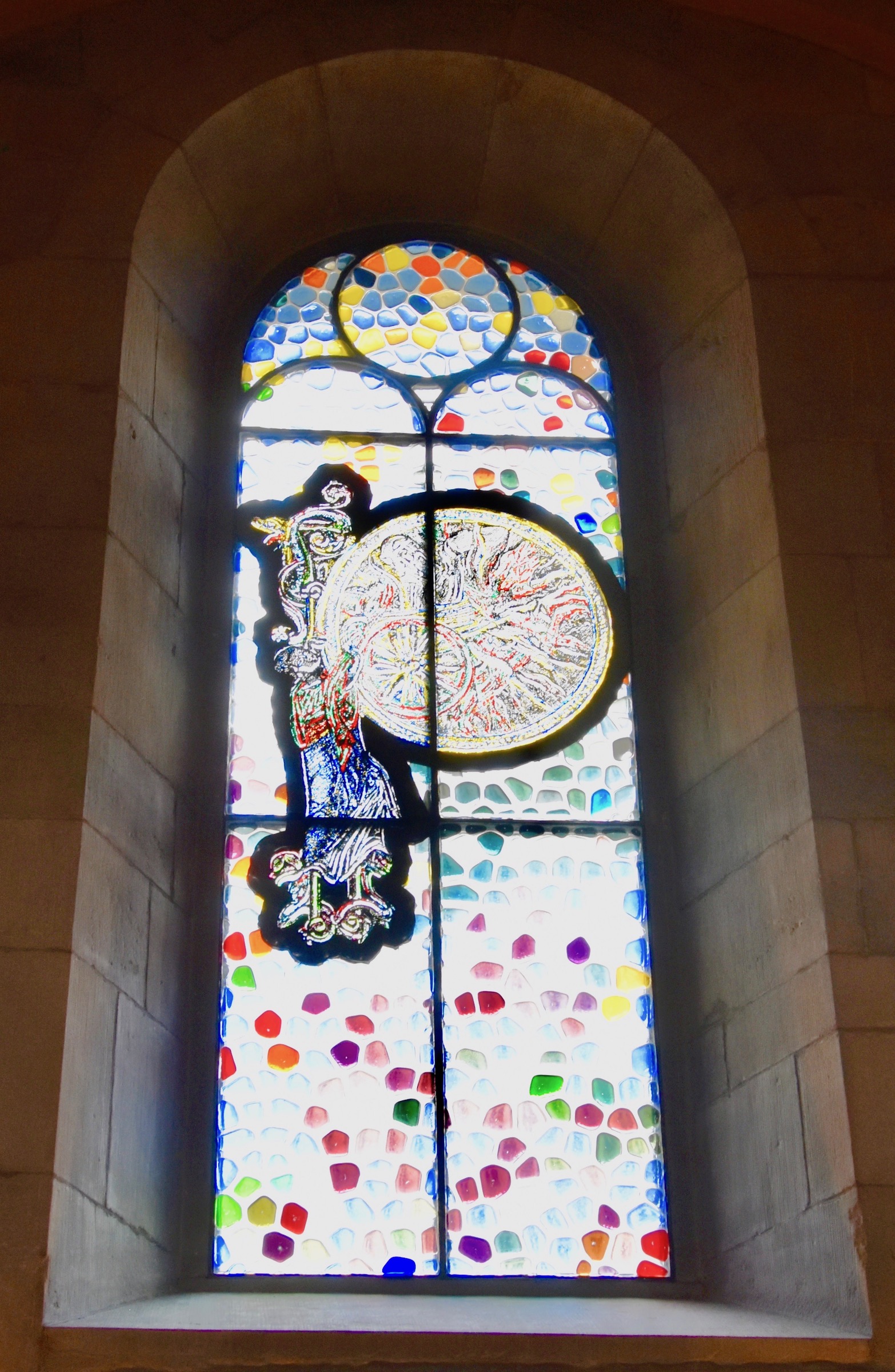
And the story of Isaac and Abraham.
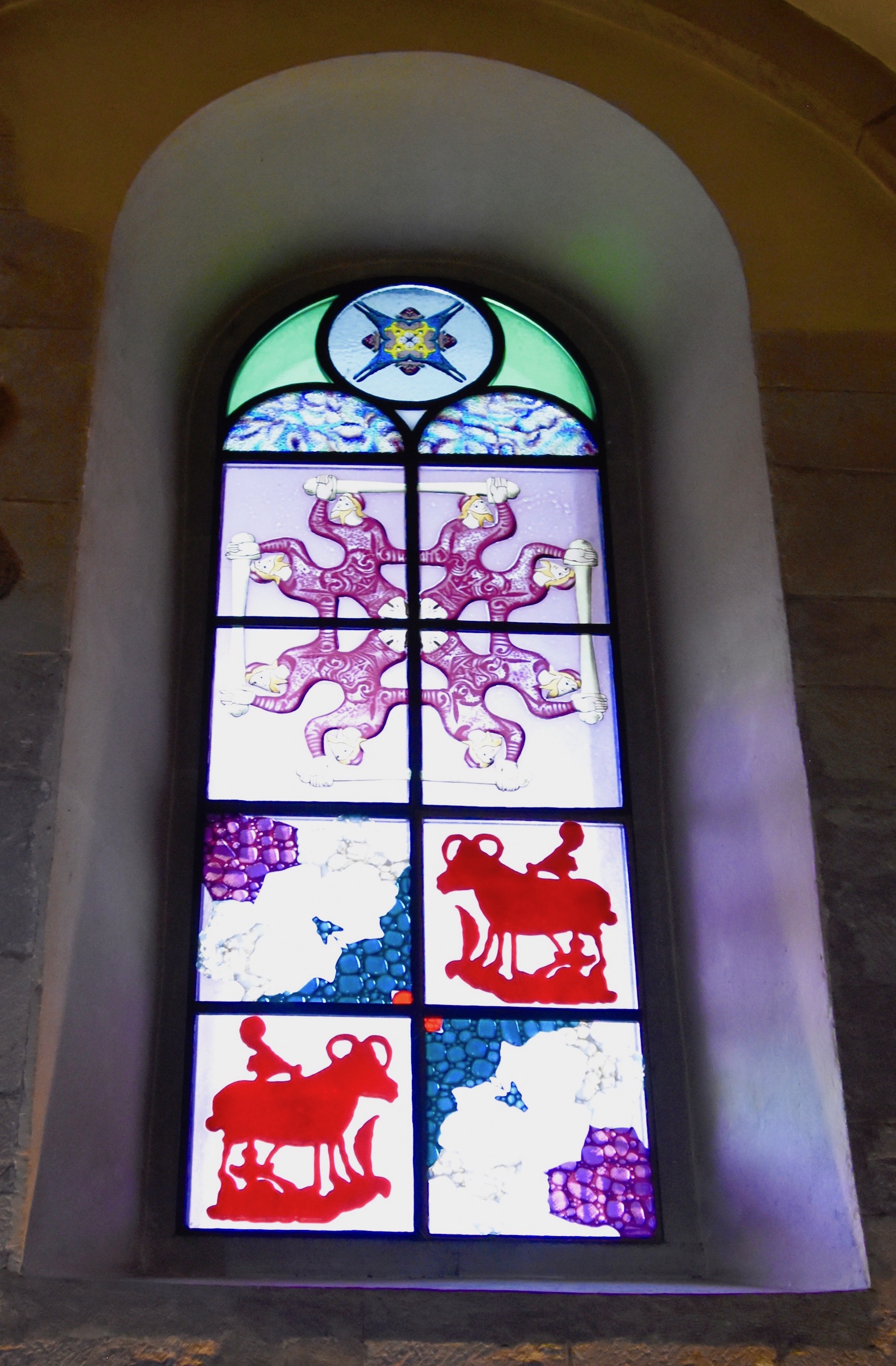
Zurich’s Grossmünster has had some great modern exterior additions as well including the bronze doors by Otto Münch. The first door was added in 1935 and depicts scenes in the manner made famous by Ghiberti’s Gates of Paradise in the Baptistry of Florence. The scenes were of events associated with the Grossmünster.
A second set was added in 1950 showing more traditional scenes from the Bible. Here is a closer look at some of them. As far I can discern we have the raising of Lazarus, the creation of good and evil, the birth of Eve from Adam’s rib, an unknown shepherd, the temptation of Eve and Jonah and the whale.
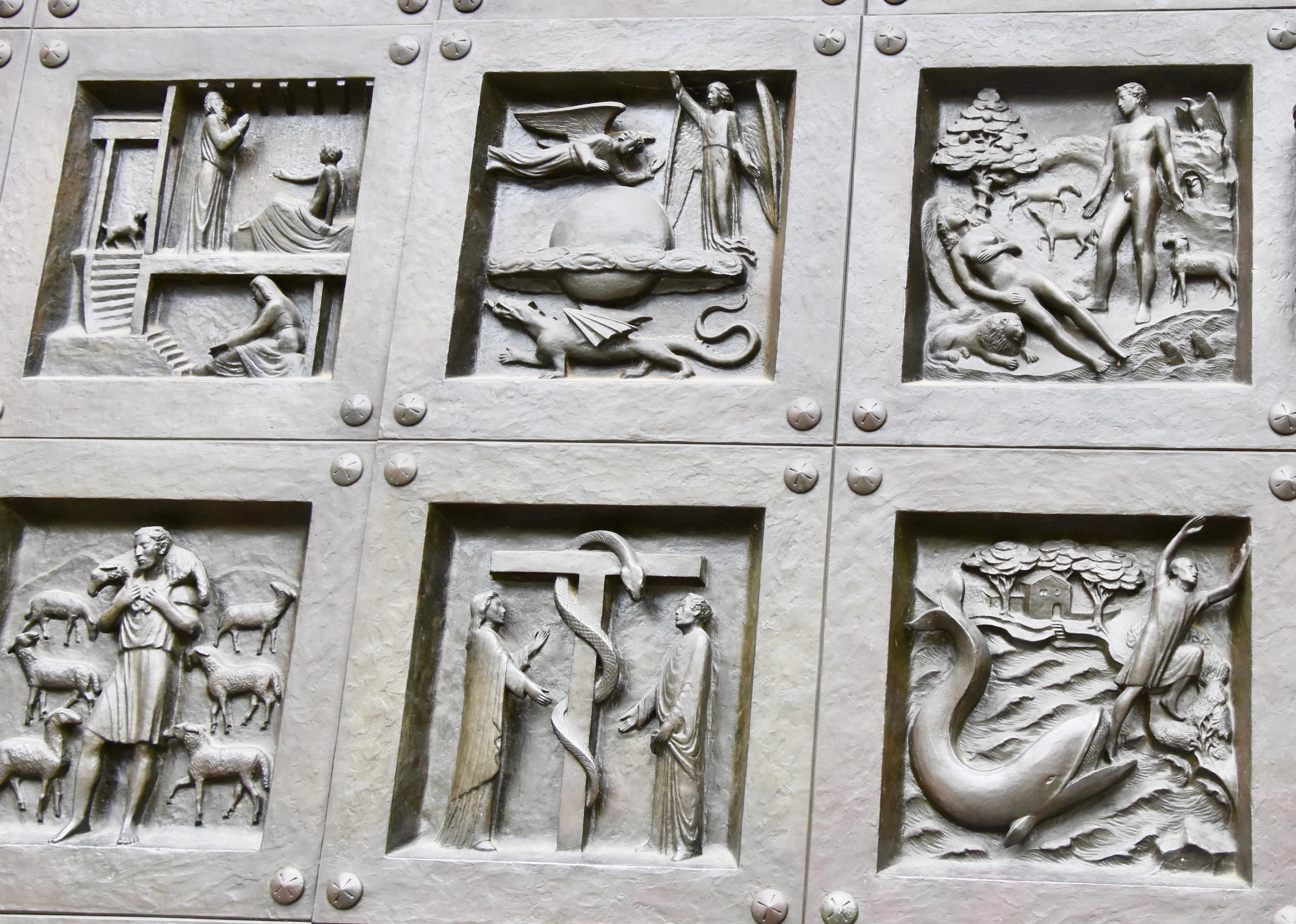
In this one we have, I think, the twelve apostles, the baptism of Jesus, the entry into Jerusalem and the resurrection. These are all beautifully done and fun to try to discern what scenes are being depicted.
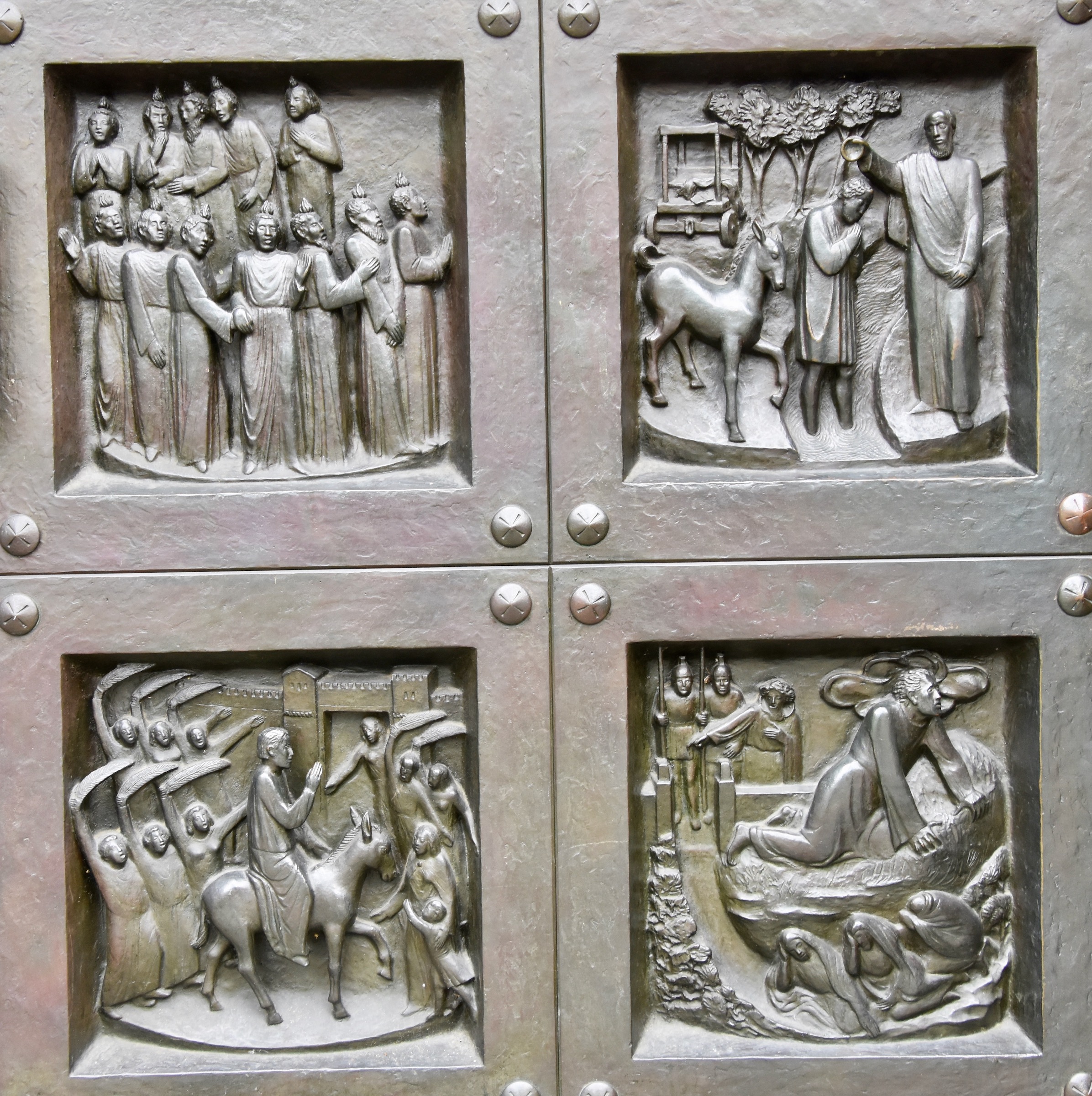
We now once again cross the Limmat to visit the Fraumünster, the great rival of the Grossmünster. As I noted earlier, Zurich was under the control of a nunnery that was established by a grandson of Charlemagne and the Fraumünster is on the spot where that nunnery first stood.
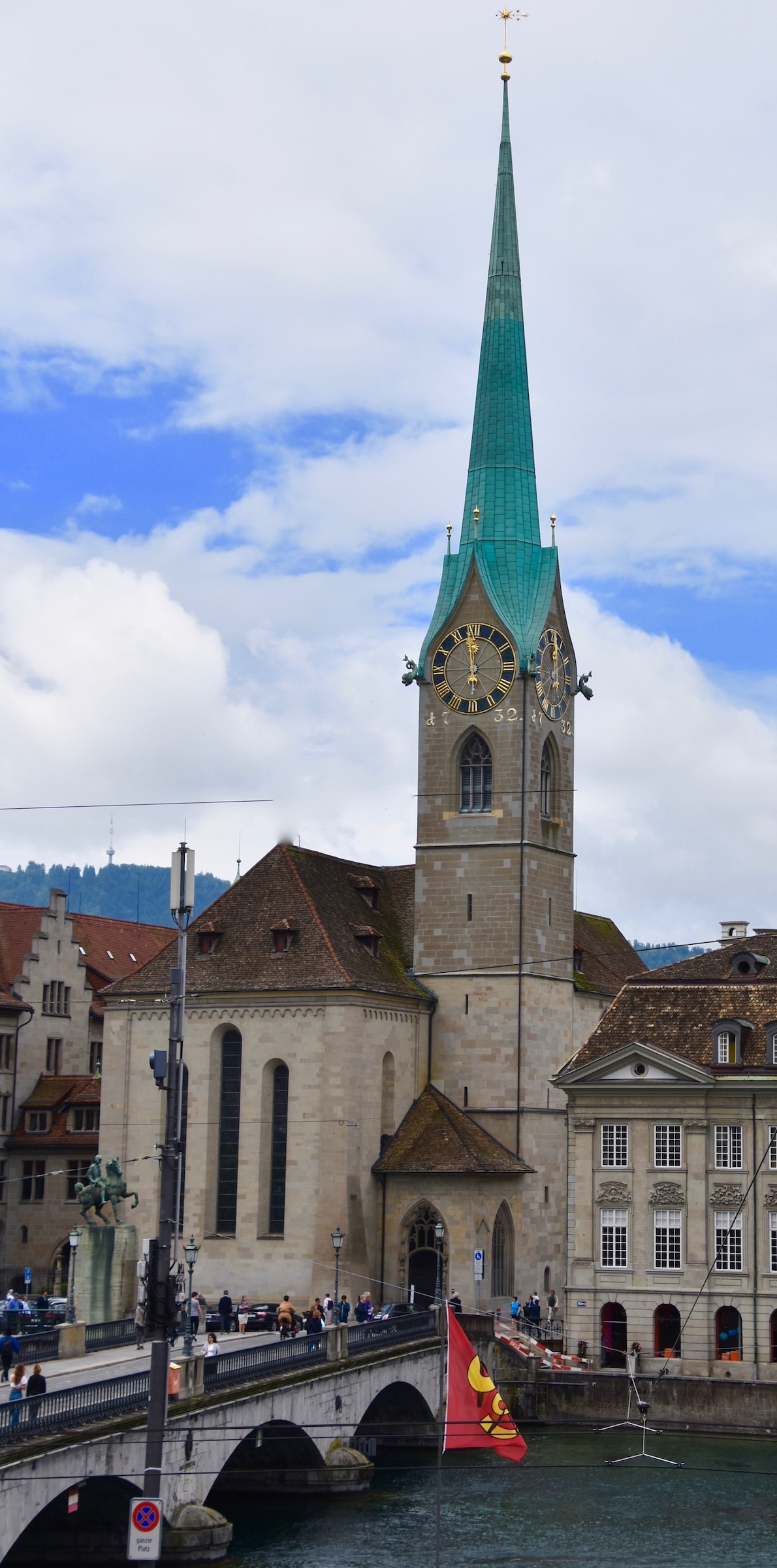
Not to be outdone by the Grossmünster’s stained glass, the Fraumünster went all out and commissioned famed Russian artist Marc Chagall to create five windows in the 1970’s. Incredibly he did this in his 80’s. They became instant classics and people come from all over the world just to see them. The masterpiece is this triptych with the central window depicting the Crucifixion, the one on the left Jacob wrestling with an angel and the one on the right, End of Days.
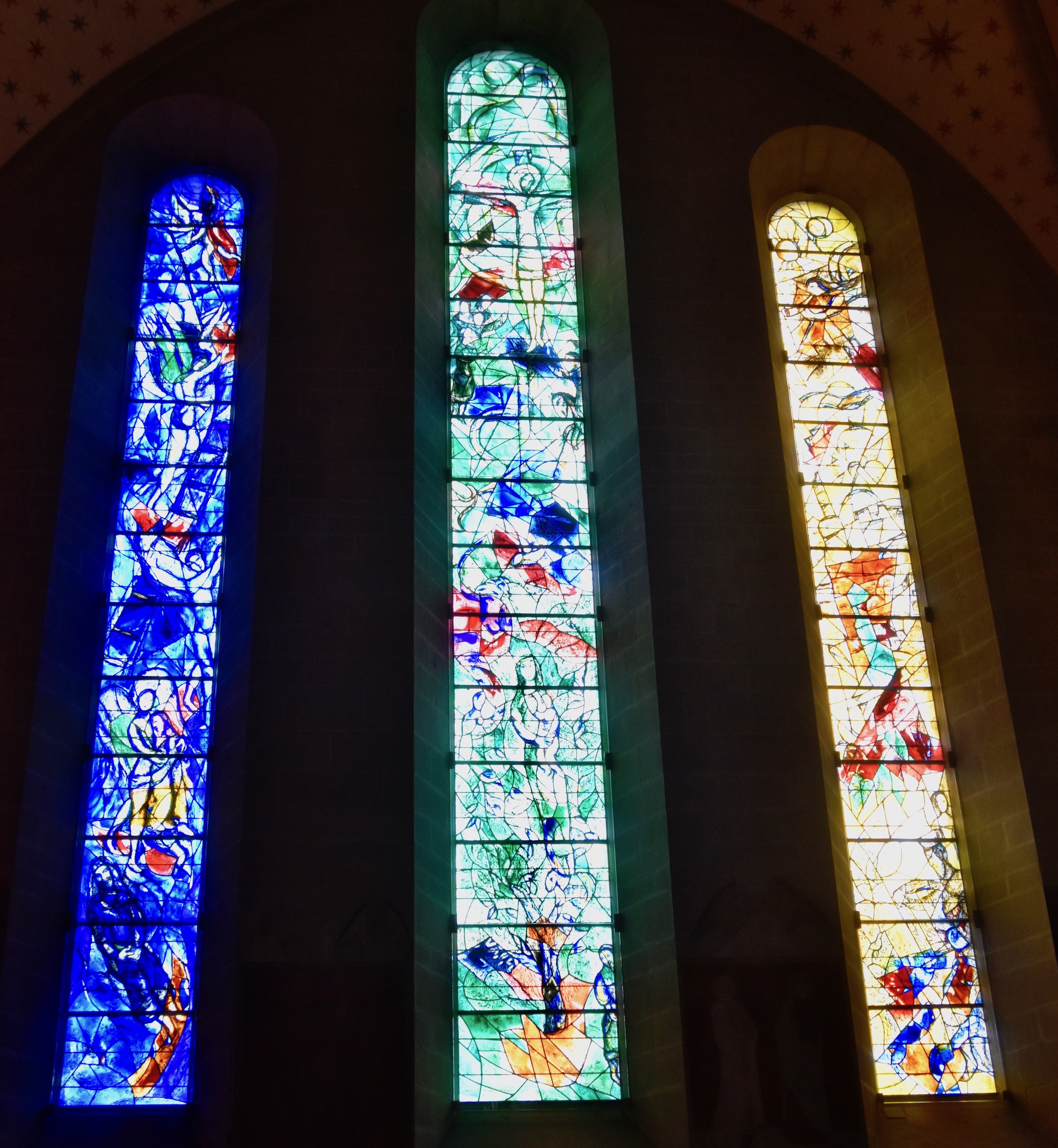
We said our goodbyes to Alla at the Fraumünster and thanked her for her excellent guided tour.
There was still some time to continue exploring Zurich on our own. It was only a short walk along the Bahnhofstrasse to the banking district and the stratospheric prices of the exclusive shops in the area. This is the headquarters of Credit Suisse, perhaps the most famous of the once totally secretive Swiss banks. As I write this the financial headlines claim that after 170 years it is teetering on the edge of bankruptcy.
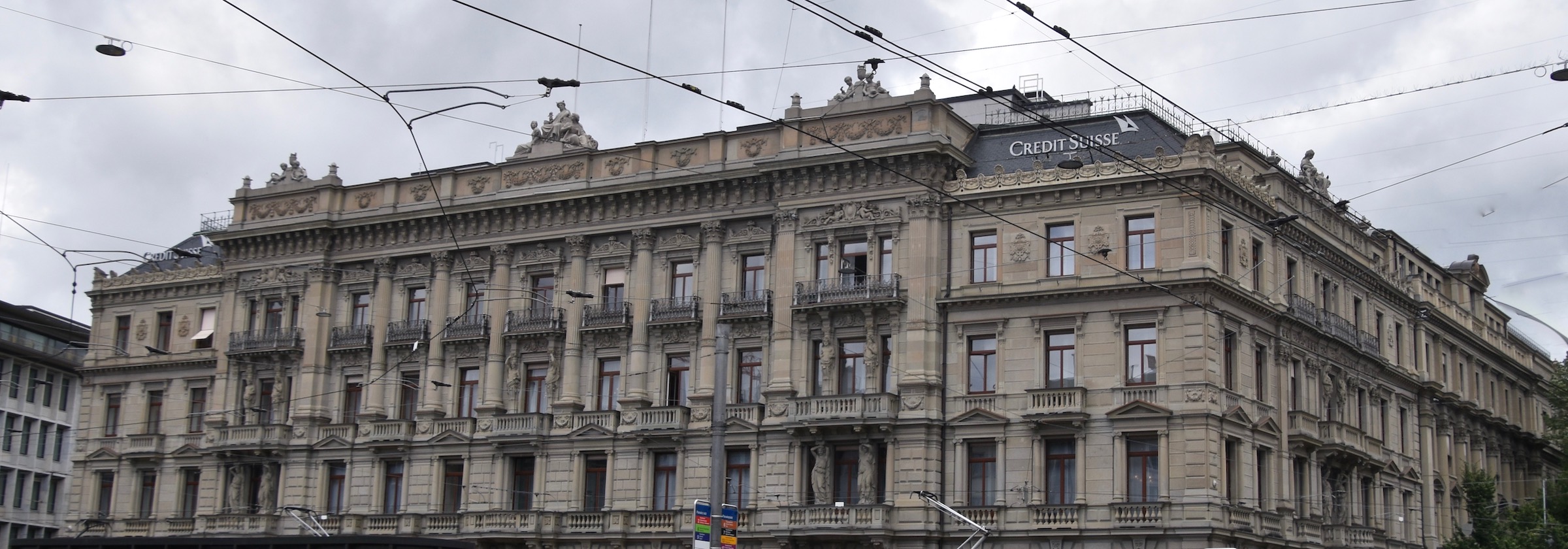
We stopped for pictures along the river and as you can see it was short sleeves weather in Zurich.
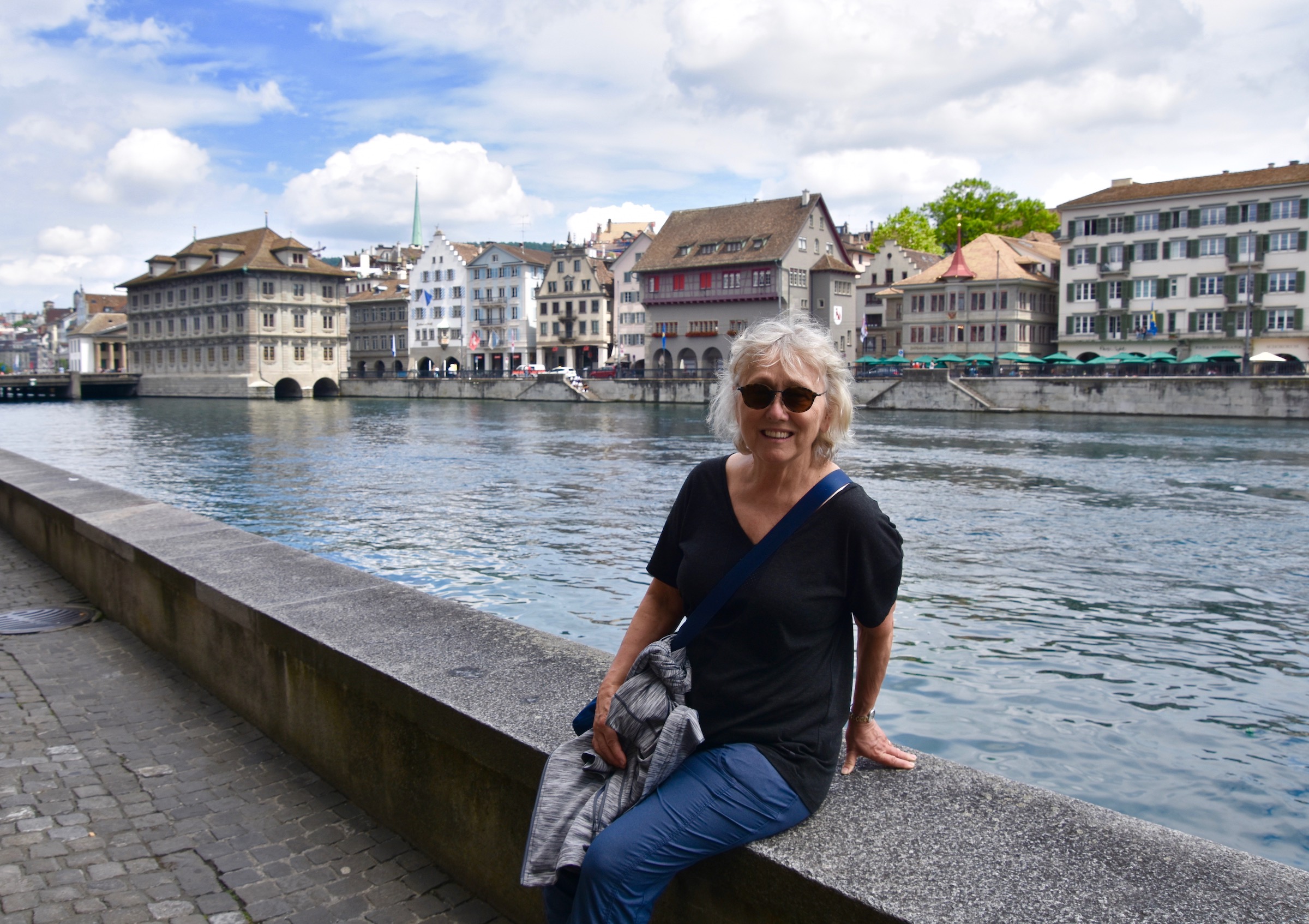
We picked a spot for lunch and I enjoyed a glass of St. Galler Klosterbrau.
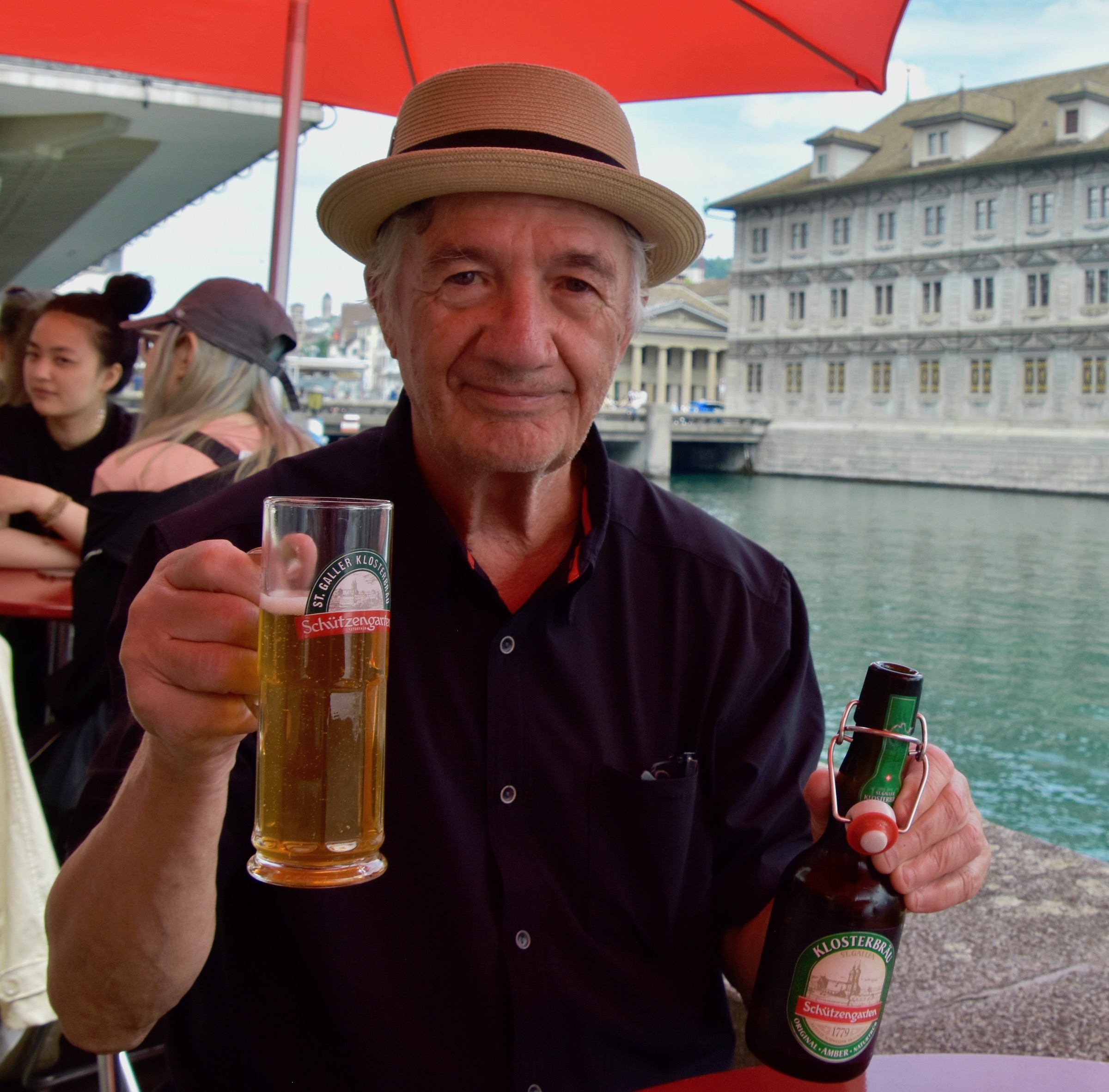
And a marvellous Swiss barley soup.
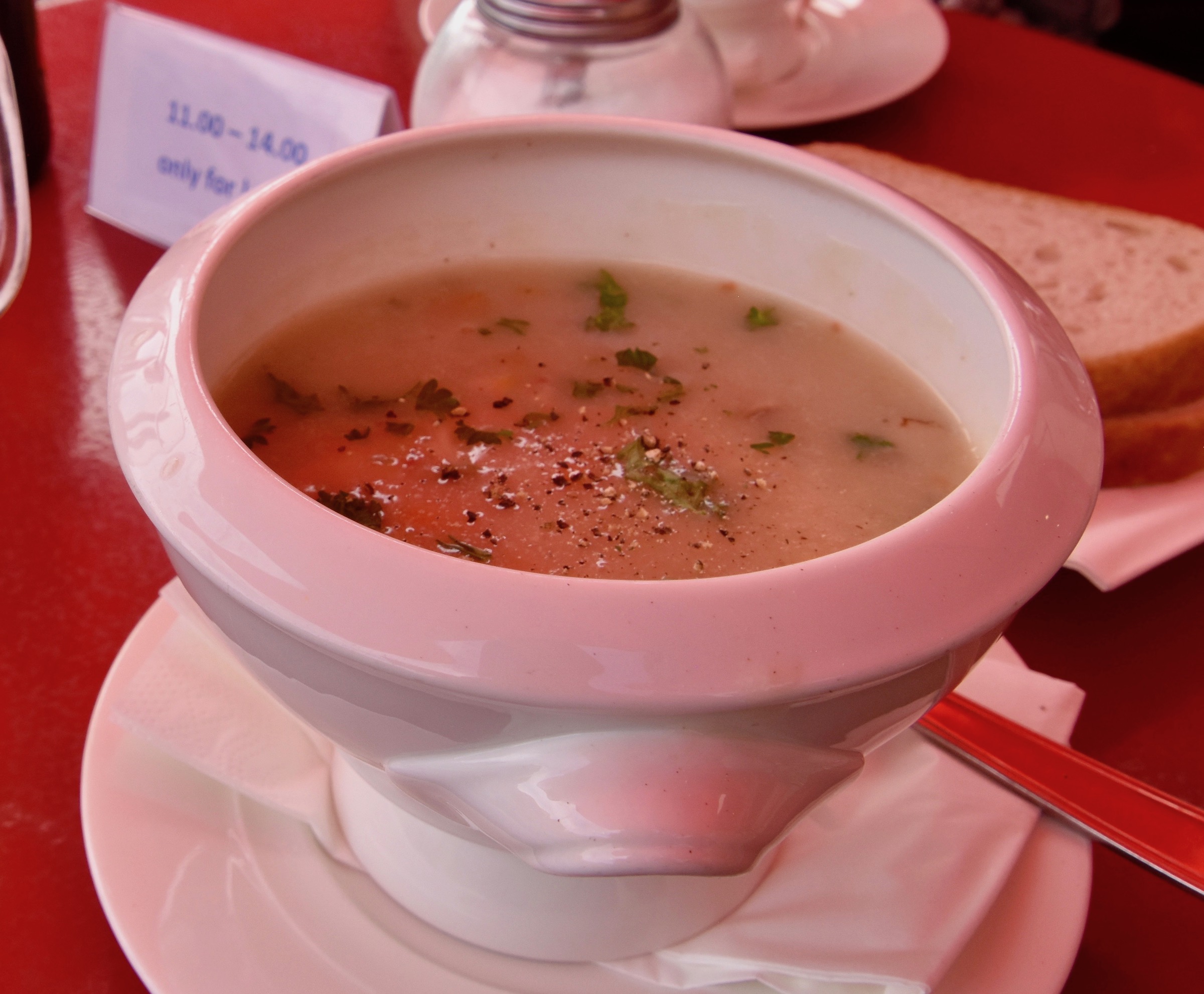
So our Swiss sojourn with Adventures Abroad is off to a great start. Tomorrow we head for the alps and the storied town of St. Moritz. I hope you’ll join us there.

